McMurdo Station
The largest research facility in Antarctica, McMurdo Station is an American scientific base located on Ross Island
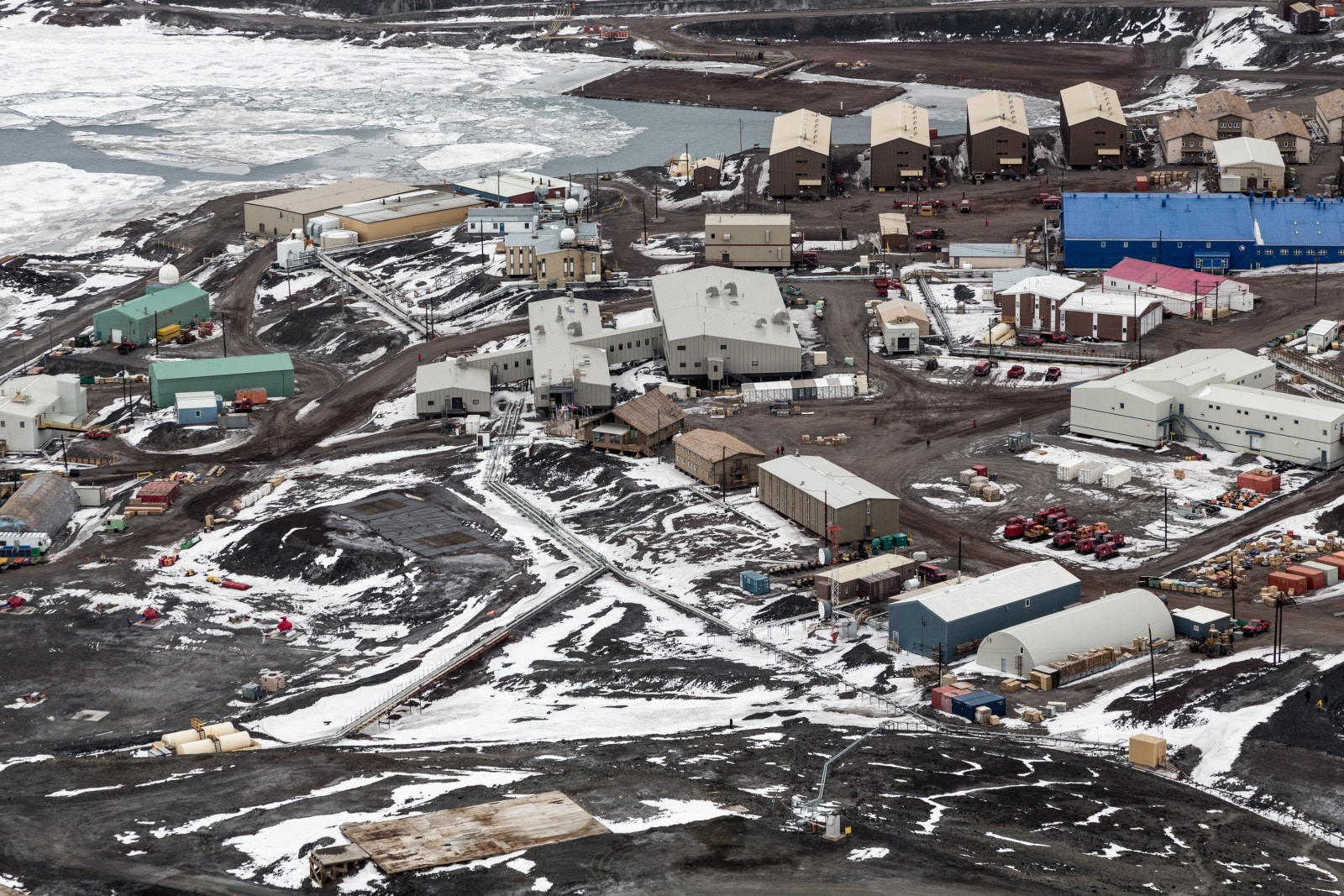
Region: Antarctica
Destinations: Ross Sea

McMurdo Station size and population
Built in 1955, McMurdo Station is the largest scientific research facility in Antarctica. It can support more than 1,200 people during the Southern Hemisphere summer, but in winter that population goes down to about 200 people.
The size of McMurdo Station can make it feel more like a village than a base. There are about 85 buildings that make up McMurdo Station, including hostels, a chapel, fire station, powerplant, harbor, and three airfields. From 1961 to 1972, there was even a nuclear reactor at McMurdo Station.
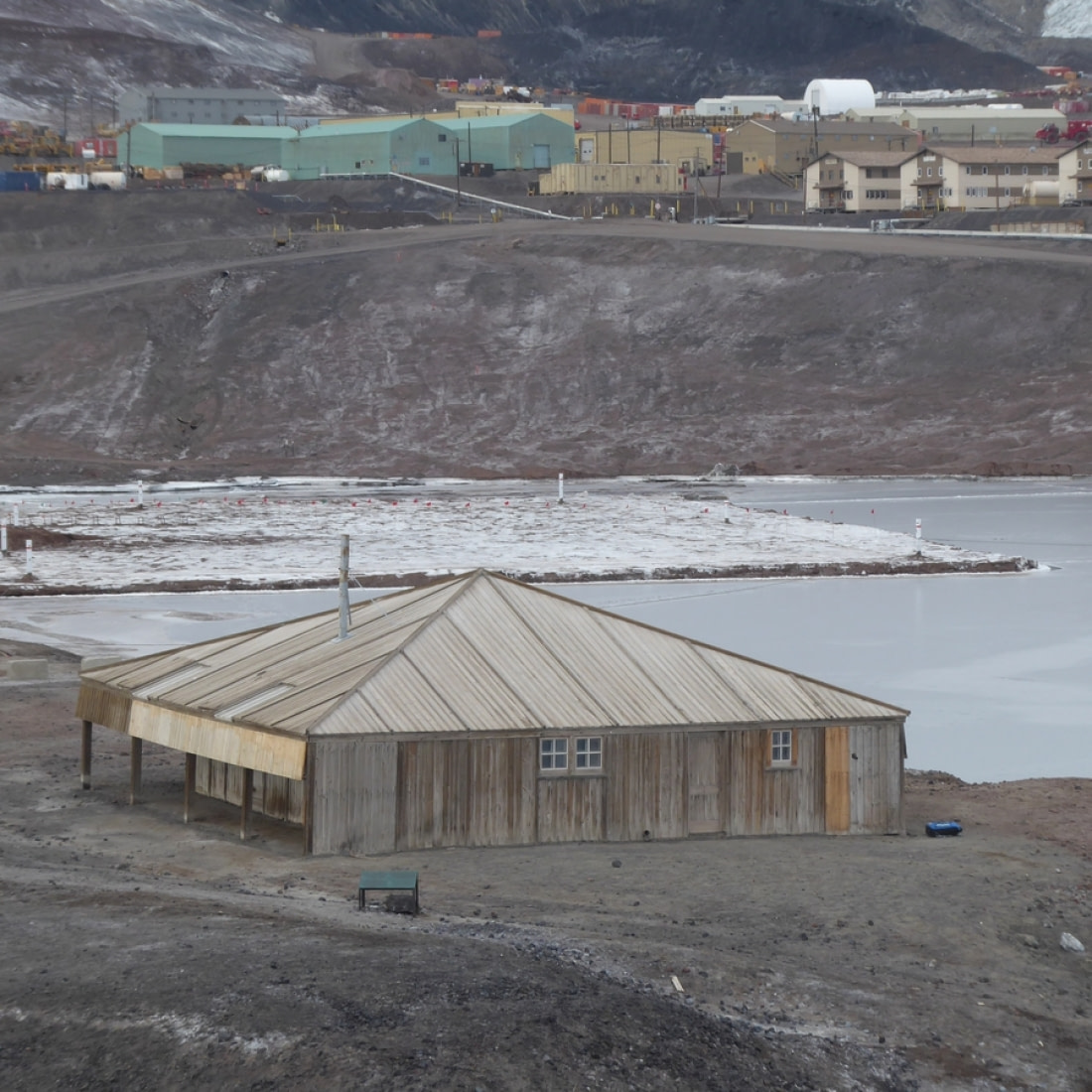
The science behind McMurdo Station
McMurdo Station’s primary purpose is scientific research. It is operated by the United States Antarctic Program, and its personnel conduct research into such fields as climatology, biology, geology, glaciology, and atmospheric studies, among others.
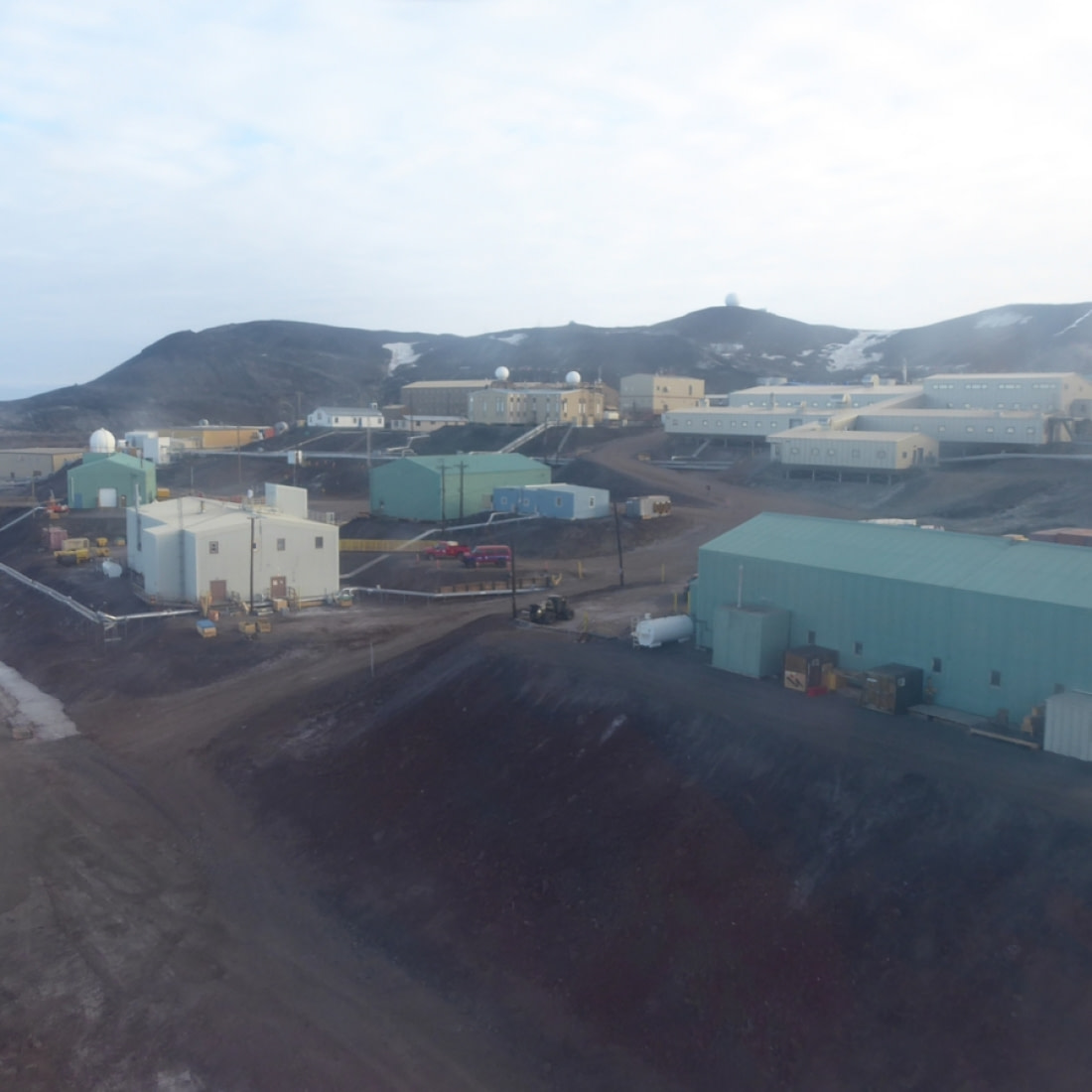
McMurdo Station’s Antarctic surroundings
Ross Island , where McMurdo Station is located, was discovered in 1840 by James Clark Ross. The island is home to two famous volcanos, Mount Erebus and Mount Terror, and is also where Ernest Shackleton and Robert Falcon Scott built wintering huts. Shackleton’s hut is on Cape Royds , and Scott’s is on Cape Evans . We visit both huts during our expeditions.
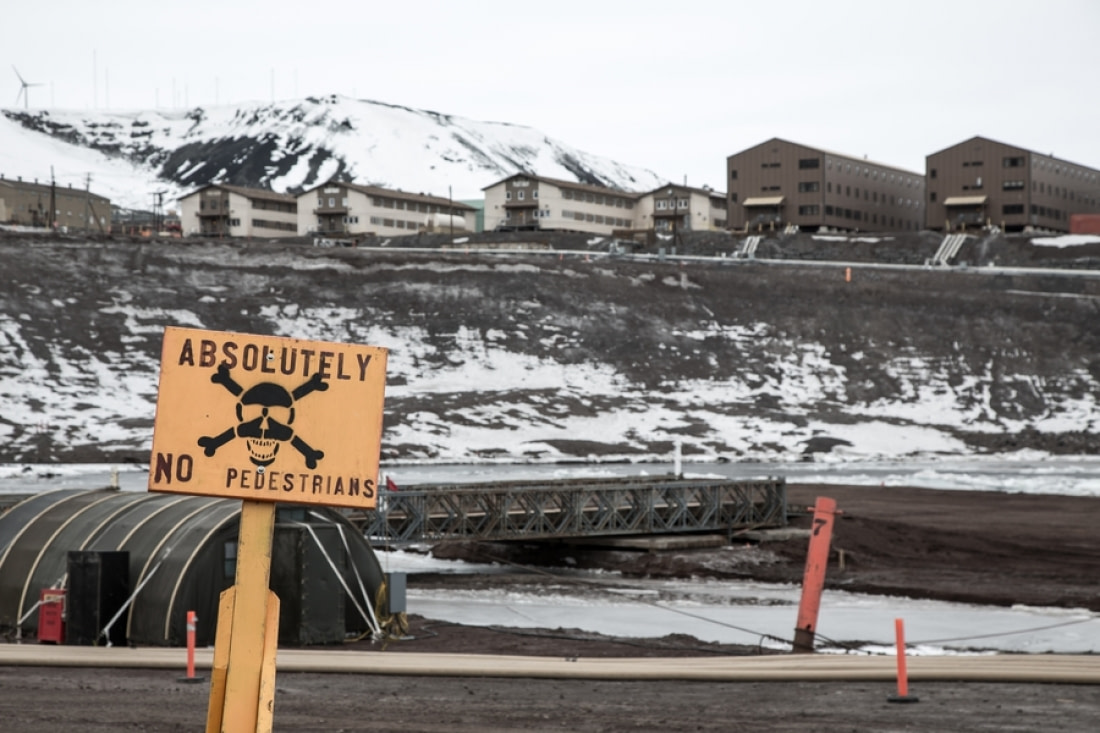
McMurdo Station
McMurdo Station (www.usap.gov, www.nsf.gov), Antarctica’s largest encampment, has the feel of a bustling frontier town, but with helicopters and icescapes. Backed by the looming active volcano of Mt Erebus, the sprawling US station is home to more than 1100 people during summer and hosts a multinational assortment of many more researchers in transit to field camps and the Pole. More than 100 buildings blanket the nearly 4 sq km between Hut Point and Observation Hill. Water, sewer, telephone and power lines all run above ground in a crisscrossing array. Called Mac Town (or just ‘Town’) by residents, the station can be an overwhelming sight after Antarctica’s clean white icebergs and lack of human presence. Approximately 250 people winterover at McMurdo to maintain the station and prepare it for the next summer season when the base refills to capacity.
Attractions
Must-see attractions.

Crary Science & Engineering Center
Symbolically numbered ‘Building 1,’ this center, usually called the ‘Crary Lab,’ is named for Albert P Crary, a geophysicist and glaciologist who was the…

Building 155
Building 155 is McMurdo’s indoor Main St, and the long central corridor is known as Hwy 1. Along it are the dining facility (still known as the Galley…

Chapel of the Snows
The white Chapel of the Snows, a 64-seat house of worship with a pretty, penguin-motif stained-glass window and an organ, is the third chapel raised at…
Purchase our award-winning guidebooks
Get to the heart of McMurdo Station with one of our in-depth, award-winning guidebooks, covering maps, itineraries, and expert guidance.

McMurdo Station Antarctica
A us research and support facility that was established in 1955 at the southernmost point of antarctica where bare ground is accessible by ship. it is the largest base in antarctica by a considerable margin with around 1000 personnel (up to 1250 possible) in summer and 250 in the winter., where is mcmurdo station.
The American McMurdo station is built on solid land on the coast of continental Antarctica at the edge of McMurdo Sound, it is situated at the southern end of Ross Island at the end of a spit of land called the "Hut Point Peninsula".

McMurdo Station seen from Arrival Heights in October 2007, White Island (left) and Black Island (right) in the background

Scott's historic hut at Hut Point with McMurdo Station in the background.
Ross Island is about 45 miles long and wide at the maximum points. McMurdo shares Ross Island with New Zealand's Scott Base and Mount Erebus, a 12,448ft (3,794m) active volcano as well as emperor penguin, adelie penguin and skua colonies and the inactive volcano Mount Terror.
McMurdo is at 77°51'S, 166°40'E between the Ross Sea and the Ross Ice Shelf. The Ross Ice Shelf is a floating area of freshwater ice fed by glaciers spilling off the continent of Antarctica that fills a huge bay approximately the size of France.
The modern McMurdo Station developed from an encampment on Ross Island at Hut Point in 1955, part of a major series of American expeditions to Antarctica as part of "Operation Deep Freeze". Initially the station was simply a collection of tents before prefabricated buildings were erected. It was originally known as Naval Air Facility McMurdo, being renamed just "McMurdo" in 1961.

The position of currently used stations on Ross Island, McMurdo (USA) and the Scott (New Zealand), and Ross Island in relation to Antarctica.

Historical Significance
Hut Point and the Hut Point Peninsula get their name from a wooden building erected in 1902 by Captain Robert Falcon Scott and used as the main base during the 1901-04 "Discovery" expedition. The hut was also used by Ernest Shackleton during the 1907-1909 "Nimrod Expedition (his main base was 20 miles away at Cape Royds) as a staging point during Scott's 1910-1913 expedition (main base at Cape Evans, between hut point and Cape Royds) and again in 1914-1917 by the Ross Sea Party of the Trans-Antarctic Expedition. The hut and surrounding area is protected under the Antarctic Treaty as Antarctic Specially Protected Area 158.
There are also the historic remains of "Vince's Cross" commemorating George Vince a member of Scott's 1901-1904 expedition who died in the vicinity in 1902, and a cross on Observation Hill commemorating Captain Scott's party all of whom died on the way back from the South Pole in 1913.
The region was first discovered by James Clark Ross in 1840 during an expedition from 1839-1843 on the ships Erebus and Terror . Many of the features in the area are named after that expedition. The Ross Sea and Ross Ice Shelf after James Clark Ross himself, Mount Erebus and Mount Terror after the ships. McMurdo Sound and subsequently McMurdo base were named after Lieutenant Archibald McMurdo, an officer on the Terror .
What happens on McMurdo Station, how big is it?
McMurdo is a center for all manner of scientific programs and experiments. It is also a starting-off point for many field parties that travel out to various places in Antarctica to carry out scientific work there. All personnel and cargo that goes to or from the Amundsen-Scott station at the South Pole first passes through McMurdo, most of the flights in and out are to Christchurch in New Zealand.
There are about 1000 personnel on station during the summer months, falling to around 250 in the winter. Many of these summer personnel are scientists, though in the winter, most are support workers. There are now over a hundred permanent structures, three ice runways and even a floating dock (wharf) made artificially of frozen freshwater. The buildings consist of a whole range of scientific laboratories, administrative buildings, workshops, garages, medical buildings, dormitory and sleeping facilities, kitchens, canteens and recreational facilities.
Terrestrial and marine biology, geology, meteorology, upper atmosphere physics, glaciology, sea-ice studies, cosmic radiation, geophysics, petrology, geochemistry and geomorphology are some of the scientific research activities that go on at McMurdo.

Most people arrive at McMurdo by air today, this is a C-17 arriving at Pegasus Field, one of three airstips around McMurdo. Pegasus Field is an ice runway capable of handling wheeled aircraft all year round. Most food and other supplies are delivered by ship.

Mount Erebus seen steaming gently in the distance from the ice runway, quite an impressive first sight when arring at McMurdo!

Sunrise and nacreous clouds over McMurdo Station seen from Observation Hill

The memorial cross erected to Captain Scott and his South Pole team in 1913, situated at the top of Observation Hill and looking down at McMurdo. Hut Point with Scott's hut is at the end of the dark spit of land on the left.
What's around McMurdo?

Above - looking across the frozen sea from McMurdo to the Royal Society mountain range, Scott's hut and Vince's cross in front.
Just up the coast from Hut Point is the Erebus Ice Tongue, the blue-white jagged projection that is sticking out into the sea-ice in the picture above left. It is fed by a glacier that flows down the slopes of Mount Erebus, large pieces break off rarely, once every 3 to 4 decades.
If you look at the interactive map below, you will see the ice-tongue points to an area to the left that appears brown with no ice cover, these are known as the "Dry Valleys" it is area where glaciers flow, but then prevailing winds cause the ice to evaporate leaving dry permanently frigid land. It is the closest place on earth to the surface of Mars and is where Mars landers and probes have been tested in the past.
Mount Erebus is one of just 5 locations world-wide where there is a permanent lava lake. There is usually enough steam or smoke being emitted to see the wind direction at the summit.
Scott Base

The road to Scott Base from McMurdo from Observation Hill.

Scott Base in the summer when snow cover is at a minimum.
Scott Base is a New Zealand run Antarctic base situated about 2 miles from McMurdo. It is much smaller than McMurdo (all other Antarctic bases are much smaller than McMurdo!) with about 25 personnel in the summer and 12-15 over the winter.
Scott has been occupied as a year-round base since 1957.
An official website of the United States government
Here's how you know
Official websites use .gov A .gov website belongs to an official government organization in the United States.
Secure .gov websites use HTTPS. A lock ( Lock Locked padlock ) or https:// means you've safely connected to the .gov website. Share sensitive information only on official, secure websites.
Geosciences (GEO)
- Research Areas
- Geosciences
- Polar Programs
McMurdo Station
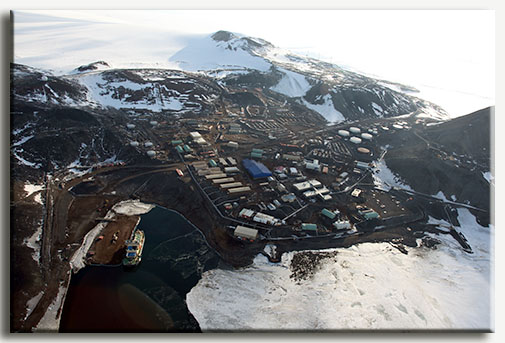
Visit the McMurdo Station webcam . Read recent reports from McMurdo Station , published in the Antarctic Sun .
McMurdo Station, located at 77 degrees 51 minutes S, 166 degrees 40 minutes E, is the largest Antarctic station. McMurdo is built on the bare volcanic rock of Hut Point Peninsula on Ross Island, the solid ground farthest south that is accessible by ship.
The station was established in December 1955. It is the logistics hub of the U.S. Antarctic Program, with a harbor, landing strips on sea ice and shelf ice, and a helicopter pad. Its 85 or so buildings range in size from a small radio shack to large, three-story structures. Repair facilities, dormitories, administrative buildings, a firehouse, power plant, water distillation plant, wharf, stores, clubs, warehouses, and the first class Crary Lab are linked by above-ground water, sewer, telephone, and power lines.
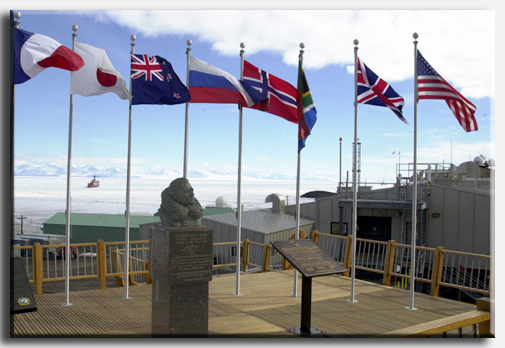
NSF chalet and the Admiral Byrd Memorial. (NSF photo by Brien Barnett)
Recorded temperature extremes have been as low as minus 50 degrees Centigrade and as high as plus 8 degrees Centigrade. Annual mean is minus 18 degrees Centigrade; monthly mean temperatures range from minus 3 degrees Centigrade in January to minus 28 degrees Centigrade in August.
Drifting snow can accumulate about 1.5 meters per year, although the station becomes snow-free in summer. Average wind is about 5.1 meters per second; a gust of 52 meters per second was recorded in July 1968.
Scientific research is performed at and near McMurdo in aeronomy, astrophysics and geospace sciences, biology and ecosystems, geology and geophysics, glaciology, geomorphology, ice cores, and ocean and climate systems. Participants of the Antarctic Artists and Writers Program also work at sites near McMurdo Station.
News from the Columbia Climate School
The Journey to Antarctica and a Week in McMurdo Station

By Jennifer Lamp
This blog post was originally drafted on November 30, but couldn’t be posted until now because the Antarctic fieldwork site lacked an internet connection. Learn more about the project here .
McMurdo Station, located on Ross Island, is one of three US Antarctic research stations, and is the largest in Antarctica. It is capable of housing more than 1,200 support staff and scientists, although for the past few years the station population during the summer season has been closer to 850. McMurdo will provide logistical support for our work, and serve as the jumping off point for our campsite in Beacon Valley, which is located about 50 minutes away by helicopter.
The beginning of the 2018-2019 Antarctic season and official opening of McMurdo Station for science projects was delayed for about 2 weeks due to an unfortunate stretch of bad weather in early October. This delay contributed to an expedited trip through Christchurch, New Zealand for our team. Normally the transit through Christchurch is a two-day process: we pick up our extreme cold weather clothing at the Clothing Distribution Center the day after arriving in New Zealand, and, weather permitting, board a flight for McMurdo the next morning. This year we had to pick up and try on our clothing, do security checks on our laptops, and then board our flight to Antarctica after lunch on the same day. Our time at the Clothing Distribution Center was a whirlwind, but due to a last-minute maintenance delay, we managed to find a few minutes to wander around the nearby International Antarctic Centre . Kate and I even had enough time to enjoy one last flat white coffee in Christchurch.
We boarded a C-17 Globemaster and took off around 6:00 p.m. local time, bound for McMurdo with a crew based out of McChord Air Force Base in Washington. We shared the plane with a Kiwi helicopter being transported to New Zealand’s Scott Base, located 1.5 miles from McMurdo Station. We landed in Antarctica on the compacted snow runway at Phoenix Airfield around 11:30 p.m., then rode for about an hour to McMurdo Station. At McMurdo we received our dorm room keys and found out we had to be at a science in-brief at 7:30 in the morning. Exhausted, we finally crawled into bed around 2:00 a.m.
Each team is assigned an event number for identification. We’re G-055; the “G” means we’re part of the USAP Antarctic Earth Sciences program (but it probably used to stand for “Geology”). McMurdo has been a deluge of trainings, meetings, packing, and equipment testing for the G-055 crew. Because we’re establishing our own standalone camp without field safety personnel, we had to complete a relatively new Dry Valleys “shakedown” training during which we set up our tents, tested our camping gear, and spent the night near McMurdo. We’ve also had general Antarctic field safety training, harassment training (technically anti-harassment training), environmental training, light vehicle training to drive the pickup trucks around station, and helicopter sling rigging training. We’ve picked up and tested our communications equipment (Iridium satellite phones, VHF radios, and a HF radio), planned our field meals and packed our food, examined, packed, and weighed our camp gear, and tested all of our science equipment to make sure it survived the lengthy trip down to Antarctica. The nonstop schedule in addition to the jet lag and adrenaline means that we haven’t been sleeping very well, but the good news is that all of our science gear made it to Antarctica unscathed!
Amongst the grind, we have been able to enjoy ourselves and take in some of the sights around the station. The work week at McMurdo is normally Monday-Saturday, but the station celebrated Thanksgiving with a 2-day holiday beginning the day after we arrived (Saturday, Nov. 24th). That night, McMurdo held its annual Thanksgiving holiday dinner—a wonderfully gluttonous way to kick off our field season. The three of us joined a tour of the sea ice pressure ridges near Scott Base where we were greeted by views of Mt. Erebus, the southernmost active volcano and one of only a few on Earth with a persistent lava lake, and sunbathing Weddell seals. We visited the Scott Base store to pick up souvenirs, and walked out to Hut Point where Robert Falcon Scott’s Discovery Hut still stands from the 1901-1904 British Discovery Expedition. Missy and I also descended the Ob Tube, a narrow metal tube with a window that extends under the sea ice in front of McMurdo, where you can watch for passing sea life and listen to the (seriously out of this world) sounds of seal calls.

We were originally hoping to depart for Beacon Valley on Nov. 30 but realized that with the Thanksgiving holiday and multitude of training sessions and meetings, we wouldn’t be finished with all of our McMurdo-based work in time. So, we’re now aiming for a Dec. 1 departure, which is incidentally also “Antarctica Day” and the 59th anniversary of the signing of the Antarctic Treaty. At the moment all of our gear is weighed, labelled, and staged at the helicopter pad. Altogether, we’ll have a camp put-in of about 3,600 pounds and will require at least 3 helicopters to deliver it all to the camp site. Tomorrow we have two flights scheduled to carry external slings (netting containing gear that hangs on a hook from the bottom of the helicopter) with all of our tents and heavy equipment, and a third one to carry us and internal cargo. We’ll all try to get a good night’s sleep now, as tomorrow is a big day!
Related Posts

In the Jersey Suburbs, a Search for Rocks To Help Fight Climate Change

Army Veteran and Environmental Advocate: A Sustainability Science Student’s Journey to Columbia

In New Jersey’s Ancient Rocks, Hunting for Clues to a 2024 Earthquake

Congratulations to our Columbia Climate School MA in Climate & Society Class of 2024! Learn about our May 10 Class Day celebration. #ColumbiaClimate2024
Thanks for the info
Thanks for the article written over two months ago. Have you spent all that time near the Dry Valleys? Maybe at one of the lakes there? I look forward to reading about your adventures.
I was fortunate enough to have visited there one day in Jan 1974 while stationed at McMurdo with USARP. There were a few dried-out, carcasses of a few ancient seals high up in the Valleys that were fascinating. Cheers!
Get the Columbia Climate School Newsletter
Antarctica and the Big Bang: Science at the World's Bottom
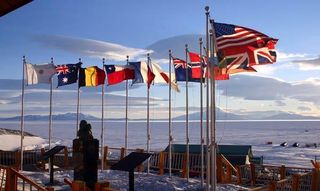
Dutch science journalist Govert Schilling recently visited Antarctica's McMurdo research station on a National Science Foundation-sponsored trip for reporters. Here, the writer offers his first-hand take on science at the bottom of the world.
In December, I spent some time at the Antarctica Hilton. This sounds much fancier than it really was. In fact, the "Hilton" is the nickname of a small shed at the intersection of two snow-covered "roads" in the vicinity of McMurdo Station, home base for American researchers on the southernmost continent, Antarctica.
One of these roads led to the Long Duration Balloon (LDB) facility, a staging ground where high-altitude balloons carrying science experiments are launched. After I made a visit to the LDB, camp manager Scott Battaion had dropped me off at the "hotel," along with Shaul Hanany of the Univerity of Minnesota, the principal investigator of a soon-to-be-launched balloon experiment. Within a few minutes, a shuttle would pick us up for the remaining 6 miles (10 kilometers) or so to "McTown."
Outside the shed, as far as the eye could see, there were snow-covered ice fields beneath a clear-blue sky, with white Mount Erebus — the southernmost active volcano in the world — gently smoking in the background. Shaul got a bit restless when the shuttle didn't show up for five, then 10, then 15 minutes. Personally, I didn't mind too much: The delay provided me with a chance to discuss the hottest episode in the history of the universe — the Big Bang — on the coldest continent of our planet — Antarctica .
Finally, a small dot appeared on the horizon. It turned out that the four-wheel-drive van had gotten stuck in a snow drift. Half an hour later I was back "home," ready for dinner at the McMurdo galley, and hopefully some more interesting encounters with Antarctic scientists.
I was fortunate enough to have been selected by the National Science Foundation as one of three participants on the 2012/2013 media trip to report on the United States Antarctic Program. This was a unique opportunity to visit the frozen continent, journey to the southernmost point of the planet, and meet a bewildering variety of scientists, from microbiologists and penguin researchers to glaciologists, climatologists, particle physicists and cosmologists. Cold as it was, this was scientific heaven. [ Images: Life at Antarctica's Concordia Station ]
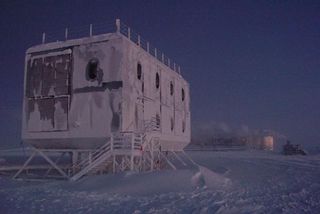
Visiting the South Pole
Get the Space.com Newsletter
Breaking space news, the latest updates on rocket launches, skywatching events and more!
Sure enough, the highlight of our visit was a day trip to the Amundsen-Scott South Pole Station on Dec. 10 — a flight of just under three hours for the propeller-driven military LC-130 Hercules freight carrier that is one of the few available aircraft able to land on the ice, using skis.
"It's a very warm day," said station support supervisor Andrea Dixon. Indeed, the temperature was a balmy minus 17 degrees Fahrenheit, which felt like minus 35 degrees F with the wind chill (minus 27 degrees Celsius, which felt like minus 37 degrees C), which, by the way, was still low enough to numb your fingers if you took off your gloves for more than a few minutes to take photographs.
Almost as daunting was the relative shortage of oxygen — the South Pole is at an altitude of 9300 feet (2835 meters) above sea level. Especially when wearing all the NSF-provided extreme-cold-weather gear, walking a flight of stairs became an exhausting endeavour.
Given all the activity going on at the South Pole, I found it hard to believe that it's only been just over a century since Norwegian explorer Roald Amundsen first reached this spot, followed just over a month later by his British rival Robert Scott, whose team perished on the way back. Now, the U.S. station is a miniature village, complete with kitchen, sleeping rooms, shop, post office, gym and sauna. During austral summers, when the sun never sets, some 150 people live and work here; during the prolonged winters, about 20 stay behind to keep things going. [ Race to the South Pole in Images ]
But in this forbidding frozen environment, you can't help notice that human presence is ultimately governed by the elements. Both the new, elevated South Pole Station and the Ice Cube Laboratory, where cosmic neutrinos are being studied, had to be designed in such a way that they can be cranked up to higher elevations in the future, lest they become buried under accumulating snow drifts.
Meanwhile, all human edifices are inexorably driven toward the remote ocean, at a rate of about 33 feet (10 meters) per year, by the glacial motion of the Antarctic ice sheet. That's why the marker for the true geographical South Pole has to be relocated every year, in a small ceremony on New Year's Day.
Neutrino lab
Obviously, it was exciting to visit the data center of the IceCube Neutrino Observatory (the actual observatory can't be seen at all — it consists of more than 5,000 sensitive detectors melted in 0.2 cubic miles, or 1 cubic kilometer, of polar ice). And it was thrilling to get a closeup view of the 10-meter South Pole Telescope, which studies the cosmic microwave background, also known as the "afterglow of creation" left behind by the Big Bang. Not to mention the excitement of discussing meteorite hunting with a NASA astronaut, and visiting the payload assembly hall for long-duration balloon flights.
But what struck me most during my visit was the passion and perseverance of scientists — biologists, geologists and astronomers alike — in their quest for knowledge.
They leave home and family behind for weeks or months on end. They fly to the most inhospitable continent of the planet, crammed up in the cargo bay of a Hercules. They have to attend classrooms and field trips to learn about survival techniques and safety measures in the harsh Antarctic environment. And then, they finally set off on their own expeditions, often working more than 12 hours per day, sleeping in tents, fighting the elements — all that to gain a better insight into the workings of our changing planet, its vulnerable biosphere and the vast universe it is part of.
When I flew back to Christchurch, New Zealand, on Dec. 13, I left a frozen world full of mysteries, and a vibrant community of truth-seekers committed to unlocking these secrets. And I took something with me (in addition to lasting memories and hundreds of pictures): a small bottle with "the cleanest air in the world," sampled and sealed at NOAA's Atmospheric Research Observatory at the South Pole. It will remain on my desk as a reminder of the purity of Antarctica.
Follow SPACE.com on Twitter @Spacedotcom . We're also on Facebook & Google+ .
Join our Space Forums to keep talking space on the latest missions, night sky and more! And if you have a news tip, correction or comment, let us know at: [email protected].
Science and music festival Starmus VII is about to rock Bratislava with a stellar lineup
China's Chang'e 6 mission to collect samples of the far side of the moon enters lunar orbit (video)
Watch monster flare-spewing sunspot grow to be 15 times wider than Earth (video)
Most Popular
- 2 Cracking! Some binary black holes may roll around each other in egg-shaped orbits
- 3 NASA's Roman Space Telescope will hunt for the universe's 1st stars — or their shredded corpses, anyway
- 4 Our neighboring galaxy's supermassive black hole would probably be a polite dinner guest
- 5 'God of Destruction' asteroid Apophis will come to Earth in 2029 — and it could meet some tiny spacecraft
© Exploratorium
I visited The Ross Sea region of Antarctica on a semi-circumnavigation of the southern-most continent in partnership with Oceanwide Expeditions . Of course, all opinions are my own.

Visiting McMurdo Sound, Antarctica
Updated March 2024 , Visiting McMurdo Sound, Antarctica was originally published in January 2021
Welcome to the Earth’s southernmost navigable body of water, McMurdo Sound. Via the Haskell Strait, the Ross Sea is connected to the largest ice shelf in Antarctica, the Ross Ice Shelf.
Few adventurers make it to McMurdo Sound and the Ross Sea, this is about as off the beaten path as you can get on planet Earth. Those that do will be rewarded with chances to view abundant wildlife, sit in the shadows of Mt. Erebus- Antarctica’s second tallest mountain, and visit the largest and remote US scientific research base at McMurdo Station.
Start planning your Antarctica voyage: The Antarctica Travel Guide
Need Travel Insurance and Evacuation Services for Antarctica?
Start shopping for travel insurance plans over at IATI Insurance . Readers of the Adventures of Nicole get a 5% discount off your plan.
The Adventures of Nicole partners with Global Rescue to offer the world’s leading medical evacuation and security advisory services. To travel with peace of mind, shop evacuation coverage at Global Rescue .

A Place Of Extremes
McMurdo Sound is probably one of the world’s most inhospitable destinations. Downright frigid katabatic winds tumble down from the Transantarctic Mountains that lie at the fringe of the Antarctic Plateau.
These winds can bring the temperatures in McMurdo Sound to a blistering -51ºC. And let’s not forget that the circumpolar currents of the Southern Sea help to prevent the more temperate waters of the South Pacific and the South Atlantic Oceans from warming.
This severe weather and cold current combo guarantees that 90% of the shorelines typically at any given time are covered in fast ice. During the winter months of June, July, and August McMurdo sound is locked under about 3 meters of ice due to these extreme conditions.
Check out 10 reasons why you should visit the Ross Sea on your Antarctic adventure
First Discovery
McMurdo Sound was first discovered by Captain James Clark Ross in February of 1841 and named after Lieutenant Archibald McMurdo. Located in a strategic position, south of Antarctica and New Zealand, McMurdo Sound was visited often by Antarctic explorers.
Ernest Shackleton and Robert Scott would both go onto build bases along McMurdo Sound in the 20th century, using the icy stretch of water as a staging point for South Pole expeditions.
McMurdo Sound Points Of Interest
Ross island.

McMurdo Station (USA)
Located on the southern tip of Ross Island, McMurdo Station is a United States Antarctic research station that is operated by the US Antarctic Program. It’s the largest human settlement in Antarctica with the ability to hold just over 1,250 people and is one of three year-round US Antarctic science facilities.

Observation Hill
Observation hill sits atop the southernmost extremity of Ross Island, effectively separating McMurdo Station from Scott Base. Ob Hill, as the ‘locals’ call it, is a 230 meter high lava dome, offering great views across the Antarctic continent, thanks to the often clear skies around McMurdo Sound.
Atop Ob Hill, you’ll find a 9-foot-tall wooden cross erected in honor of the last members of Robert Falcon Scott’s party, whose bodies lie encased within the Ross Ice Shelf.
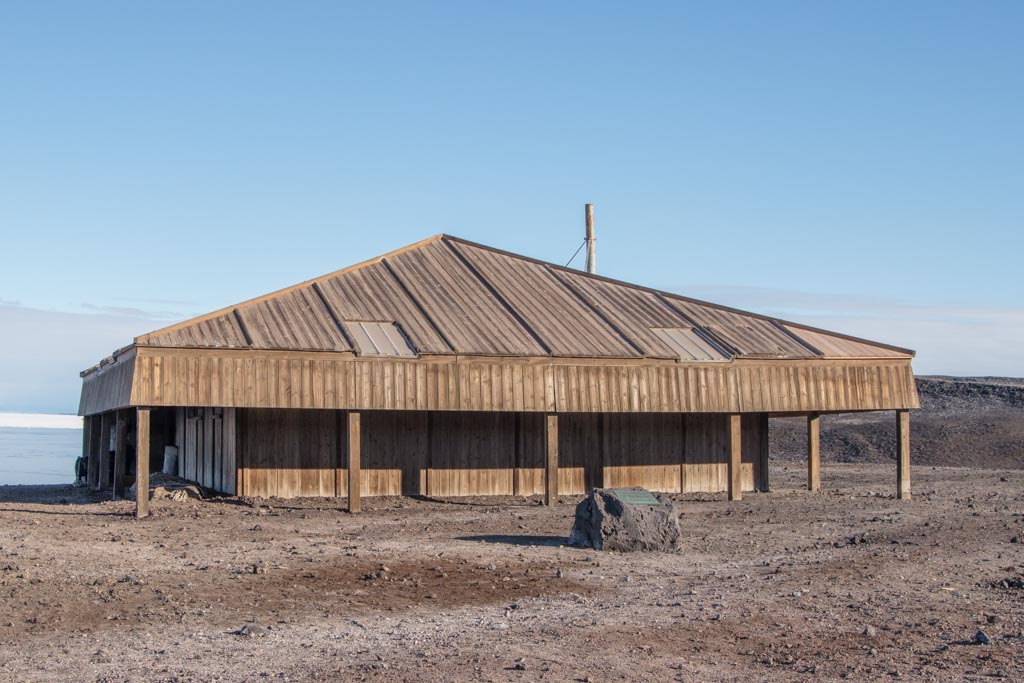
Discovery Hut
Built in 1902 during the Discovery Expedition by Robert Falcon Scott, Discovery Hut sits prominently atop Hut Point, just 300 meters away from McMurdo Station. Commonly, Discovery Hut is confused with Scott’s Hut located not far away at Cape Evans, also built during the British Antarctic Expedition of 1910–1913, led by Robert Falcon Scott in 1911. Discovery Hut has been designated a historic monument.
Discovery Hut would go on to be used throughout several expeditions that took place between 1902 and 1917. After Shackleton left the hut in 1917, it sat untouched until 1956 when US expeditions during Operation Deep Freeze dug it out from snow and ice. The cold helped to preserve Discovery Hut and its contents, though the seal meat left behind in their does not smell pleasant.
Get a copy of Bradt’s Antarctica wildlife guidebook before you set off for Antarctica
Scott Base (New Zealand)
Scott Base is the New Zealand Antarctic research facility, located at Pram Point on Ross Island, just on the opposite side of Ob Hill from McMurdo Station. The base houses 85 people during the summer season and a paltry 10-14 in the winter.
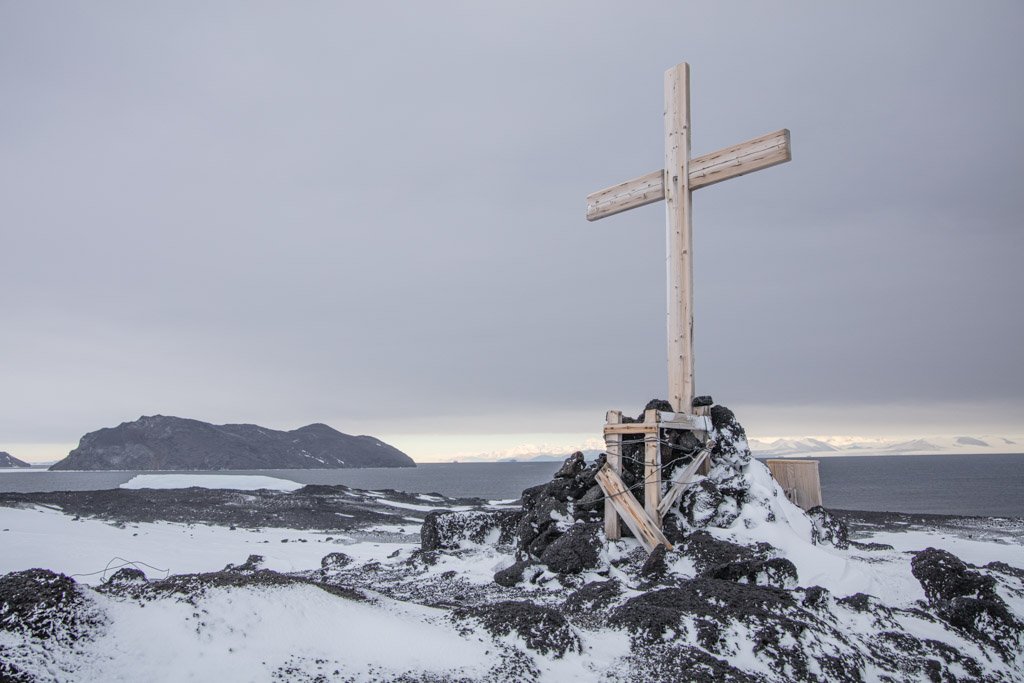
Scott’s Hut, Cape Evans
Located on the north shore of Cape Evans, toward the west of Ross Island sits Scott’s Terra Nova Hut. The hut was constructed in 1911, as Scott rejected the idea of reusing nearby Discovery Hut, a prefab construction, assembled in England before it made the journey down to Ross Island by ship. Significant effort was put into insulating Scott’s Hut, to make it warmer than Discovery, using layers of quilted seaweed and rubber ply.
A cross sits prominently outside Scott’s Hut constructed in memory of the three members of Shackleton’s Ross Sea Party, who died not far from here.
Similar to Discovery Hut, Scott’s Hut sat untouched until 1956 when it was rediscovered. Furthermore, Scott’s Hut is fairly well-preserved, owing to the fridge temperatures that plaque the area.

Mount Erebus
Mount Erebus is the second-tallest active volcano in Antarctica at a staggering 3,794 meters and the continent’s southernmost. Several expeditions have summited the volcano with an active lava lake at its apex. Mount Erebus is likely most famous as the site of the Mount Erebus Disaster when sightseeing flight Air New Zealand flight 901 in November 1979, killing all 237 passengers and 30 crew on board.
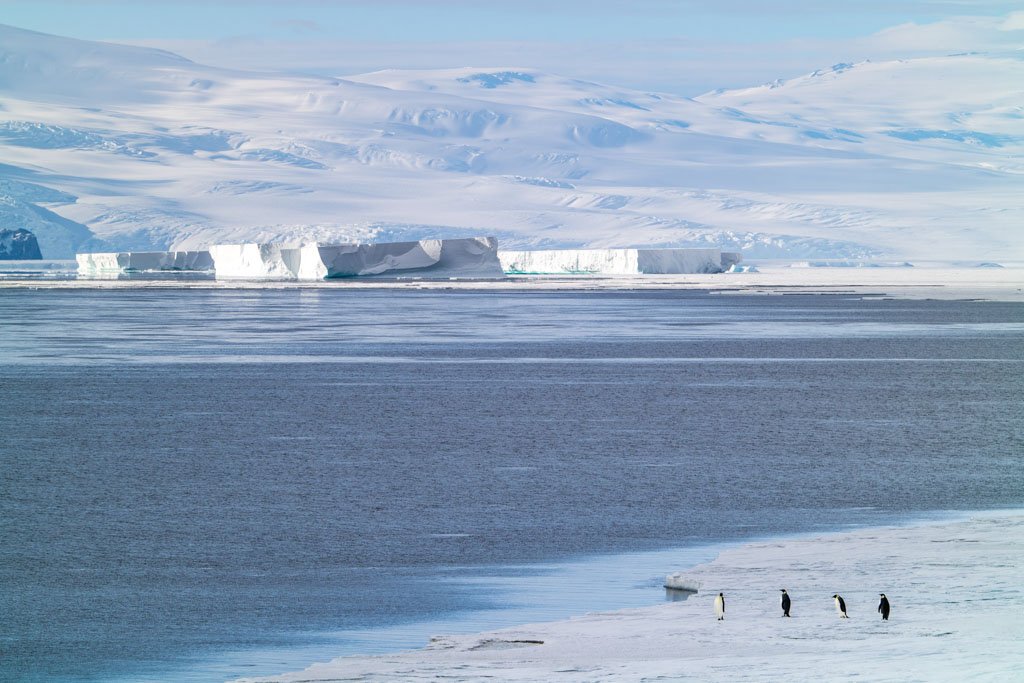
Mount Terror, Mount Bird, & Mount Terra Nova
The three inactive volcanoes of Mount Terror, Mount Bird, and Mount Terra Nova rise from Ross Island in the shadows of Mount Erebus at 3,230 meters, 1,765 meters, and 2,130 meters respectively.
Erebus Ice Tongue
The Erebus Ice Tongue is a seaward extension of Erebus Glaciers as it tumbles down off of Mount Erebus and into McMurdo Sound. The ice tongue juts 11 kilometers into McMurdo Sound from near Cape Evans on Ross Island. The calm waters protected by Cape Evans and Cape Royds help to preserve the Erebus Ice Tongue that was formed by the rapidly flowing glacier ice stream of Erebus Glacier.
Cape Royds extends from the west of Ross Island into McMurdo Sound, named after Lieutenant Charles Royds. Shackleton’s Hut was constructed at Cape Royds in 1908. Flagstaff Point is Cape Royds’ southernmost point.
Shackleton’s Hut
Built in 1908 during the Nimrod Expedition, 37 kilometers north of the previously built Discovery Hut located at Hut Point.
Shackleton’s Hut was designated a historic site, and in 2008 the hut was fully restored to its conditions at the time Ernest Shackleton and his party left it. Interestingly in 2006 five crates of McKinlay and Co. whisky were found buried under the hut.
Looking for inspiration? Check out 10 reasons to visit Antarctica
Coastal McMurdo Sound
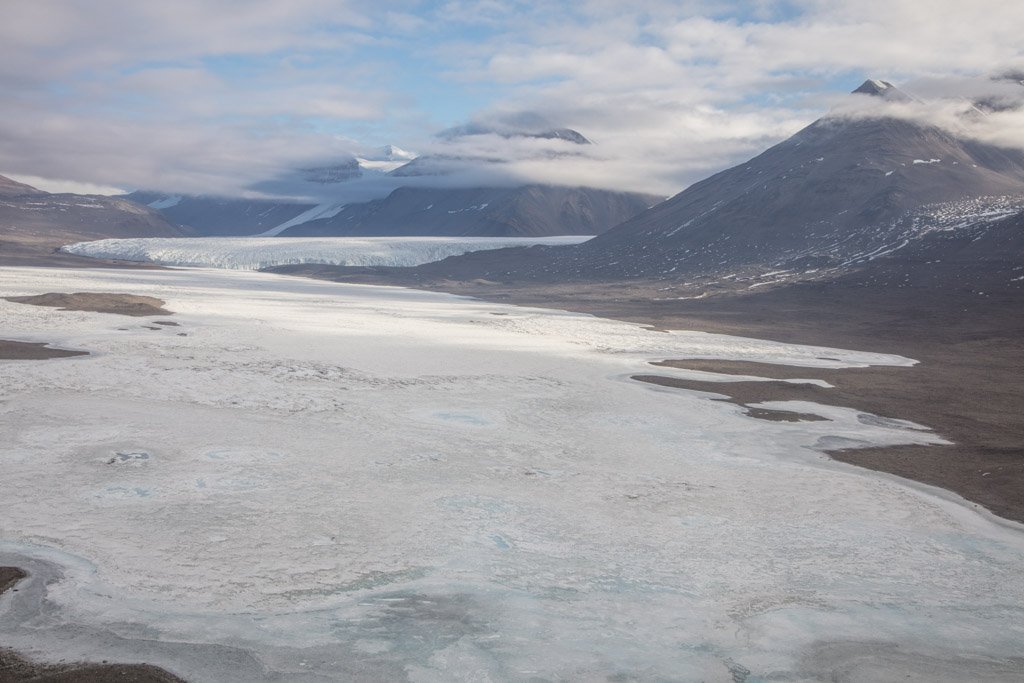
McMurdo Dry Valleys
Located west of McMurdo Sound, the McMurdo Dry Valleys are one of the strangest places on Earth. Victoria Valley, Wright Valley, and Taylor Valley are the three main valleys, with McKelvey, Belham, Barwick, Alanta, Stuiver, Wall, Virginia, Priscu, Pearse, Miers, Garwood, and Marshall Valleys all comprising the smaller valleys of the area. These snow-free* valleys are some of the driest places you’ll find on Earth.
The McMurdo Dry Valleys are in a unique location that allows for them to be so dry. The Transantarctic Mountains that back the valleys prevent seaward-flowing ice from spilling down from the East Antarctic Ice Sheet and onward into the Ross Sea. The Dry Valleys receive about 100 millimeters of precipitation (snow) per year, but it is typically evaporated almost instantly by the dry winds that plague this region.
Probably the most well-known and most fascinating feature of the McMurdo Dry Valleys is the Blood Waterfall that spews from the side of Taylor Glacier in Taylor Valley.
*Usually snow-free. My friend Darrell Day was in Taylor Valley this past February of 2020 standing in a foot of snow in a place where it pretty much never snows.
Read more about the McMurdo Dry Valleys and my experience there
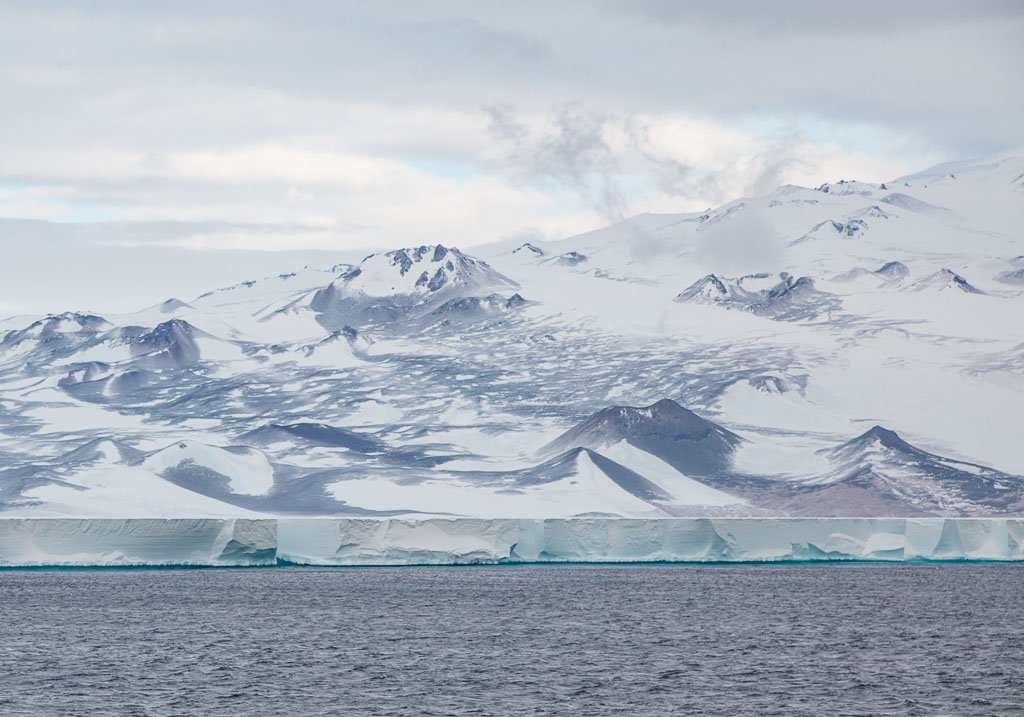
McMurdo Ice Shelf
The McMurdo Ice Shelf is a portion of the Ross Ice Shelf, the largest ice shelf in Antarctica, bounded by Ross Island and McMurdo Sound to the north, Minna Bluff, White Island, and Black Island to the south, and the Transantarctic Mountains to the west.
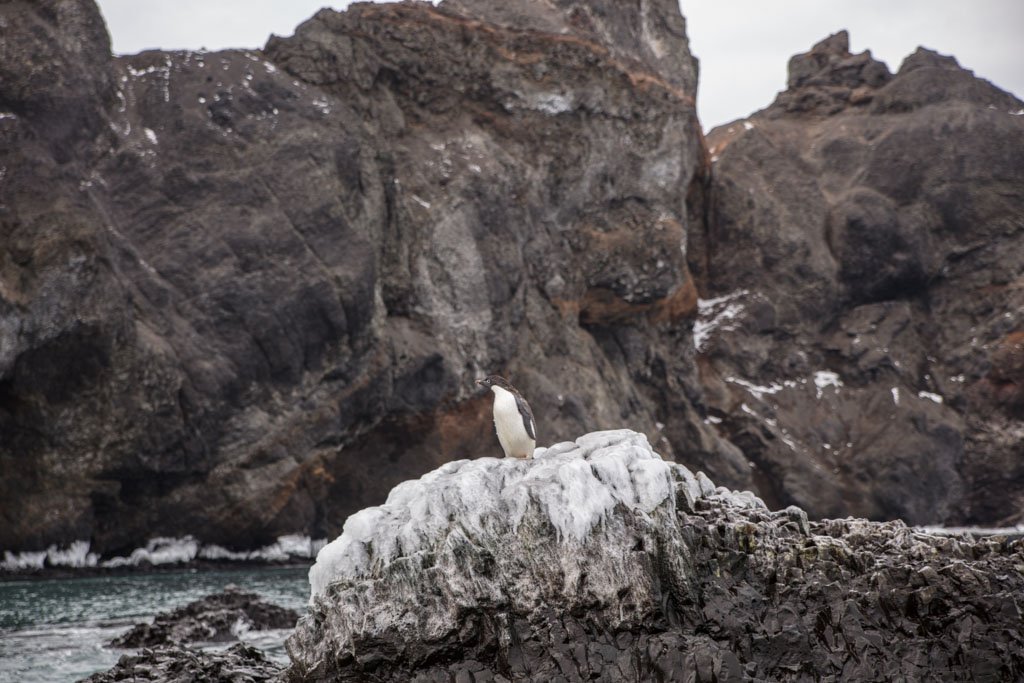
Franklin Island
Lying at the fringe of McMurdo Sound and Terranova Bay sits little Franklin Island, named after Arctic explorer Sir John Franklin and discovered by James Clark Ross in 1941. Franklin Island is the remnant of a shield volcano with its vent sunk off the east coast of the island.
Franklin Island is home to a large Adelie penguin colony, whose rookery is towered over by the looming cliff named Bernacchi Head.
Read up more on Franklin Island and its famous Adelie colony
Drygalski Ice Tongue
Extending out from Scott the Scott Coast, just south of Zucchelli Station sit the Drygalski Ice Tongue stretching 70 kilometers into McMurdo Sound from David Glacier, located in the Prince Albert Mountains of Victoria Land. Named after German Professor Erich von Drygalski, a Prussian-born Antarctic explorer. The Drygalski Tongue is thought to be at least 4,000 years old.
Terra Nova Bay
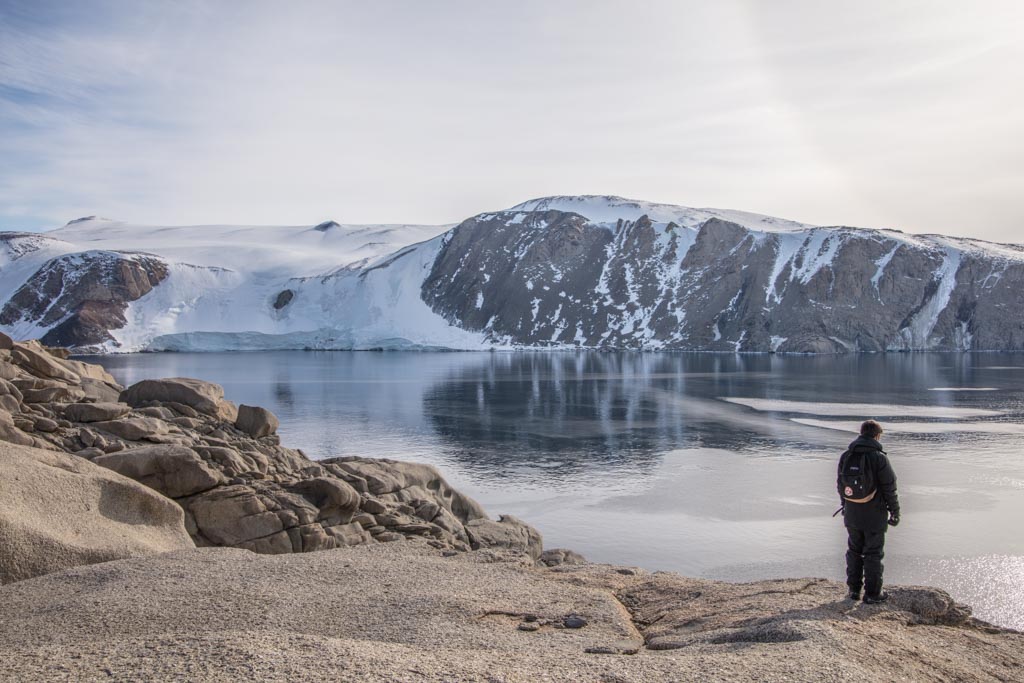
Zucchelli Station (Italy)
Zucchelli Station, named after Mario Zucchelli, who served as the director of activities for the ENEA-Unità Tecnica Antartitide as part of the National Antarctic Research Program (Italian Antarctic Program) for 16 years. It’s an Italian research facility, set at the edge of the Gerlache Inlet on the shores of Terra Nova Bay, just north of McMurdo Sound. Zucchelli Station is only open seasonally from October to February every year.
Jang Bogo Station (South Korea)
Jang Bogo Station sits at the terminus of the Gerlache Inlet between Zucchelli and Gondwana Stations. It is a South Korean research station named after the eighth-century maritime ruler of Korea who controlled the Yellow Sea. Jang Bogo is a newer station, completed in 2014 with the capability to house 60 staff in summer and 15 in winter.
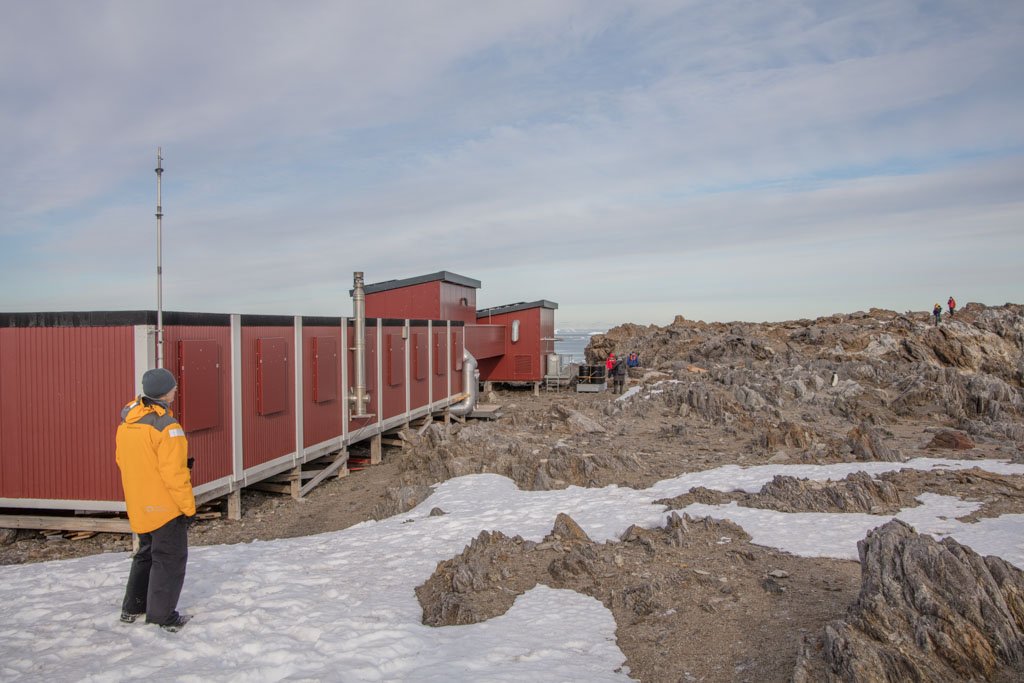
Gondwana Station (Germany)
Sitting just north of both Zucchelli Station and Jang Bogo Station along the Gerlache Inlet at the fringe of the Transantarctic Mountains sits Germany’s Gondwana Station. The station was built in 1983 and is operated by the Federal Institute for Geosciences and Natural Resources. The base supports the GANOVEX (German Antarctic North Victoria Land Expedition) during expeditions.
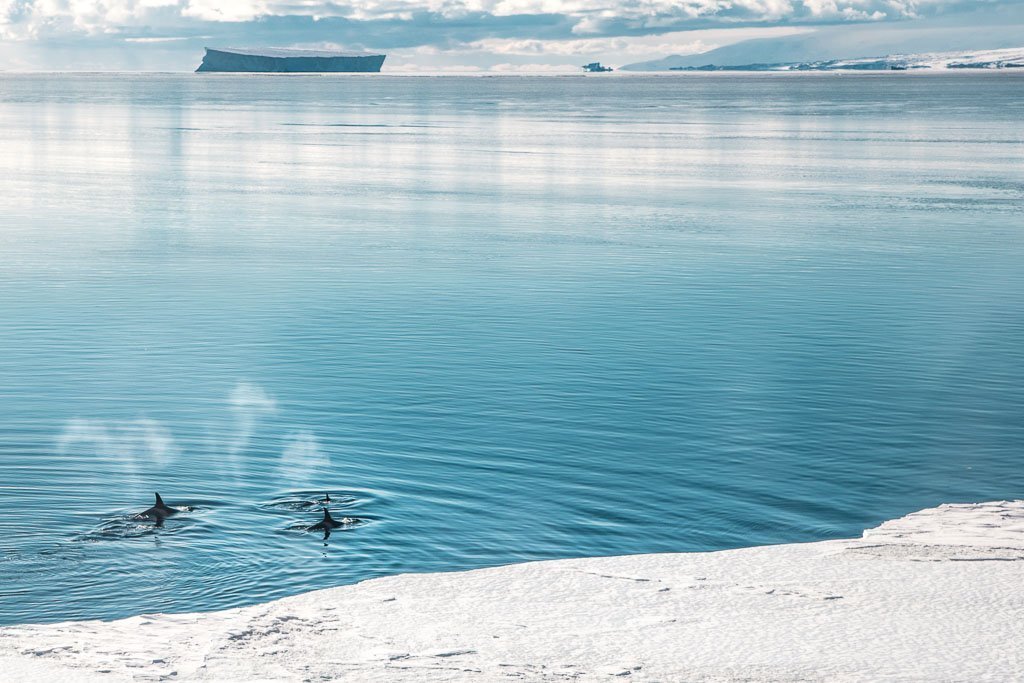
How To Visit McMurdo Sound
Unless you score a job at one of the Antarctic Bases centered around McMurdo Sound (the odds are not in your favor), your most realistic option for visiting the Ross Sea is via a Ross Sea cruise.
Oceanwide Expeditions offers a Ross Sea Crossing (this is the actual trip I did) that takes you between New Zealand and Argentina on a semi-circumnavigation of the continent. Another advantage of this trip is that there are helicopters aboard the M/V Ortelius.
Heritage Expeditions offers a Ross Sea trip that starts and ends in Bluff, New Zealand. Price-wise it’s roughly the same as Oceanwide’s Ross Sea Crossing.
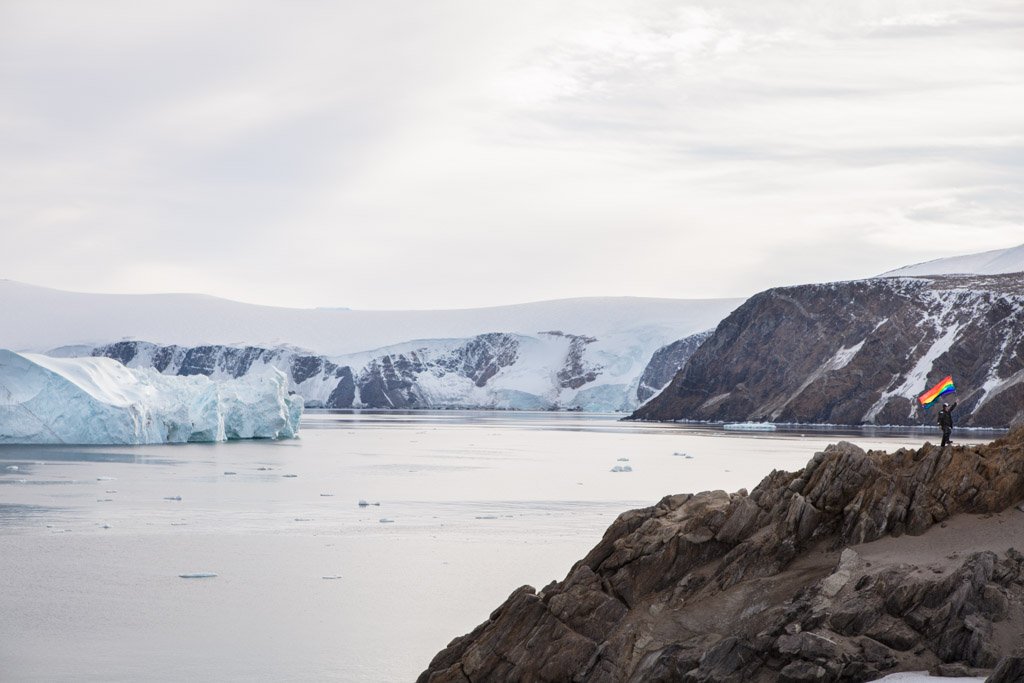
Have Any Questions About Visiting McMurdo Sound?
Ask in the comments section below.
More posts from Antarctica:
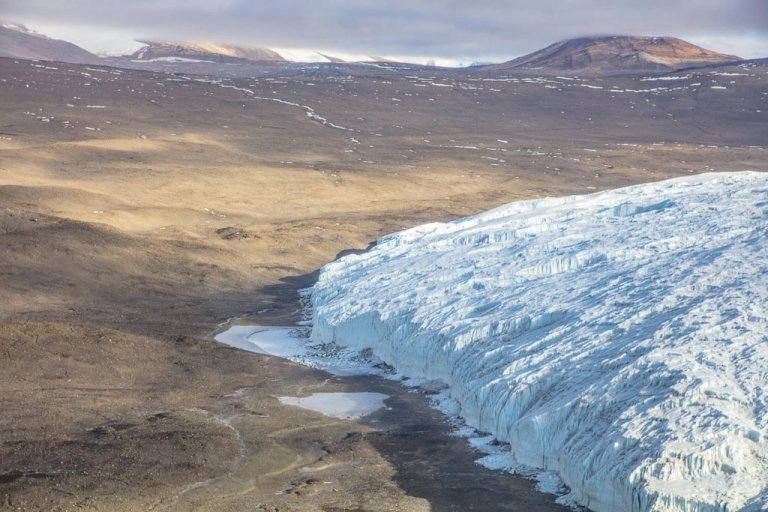
McMurdo Dry Valleys: Visit Mars Without Leaving Earth

Off The Beaten Path New Zealand: Campbell Island
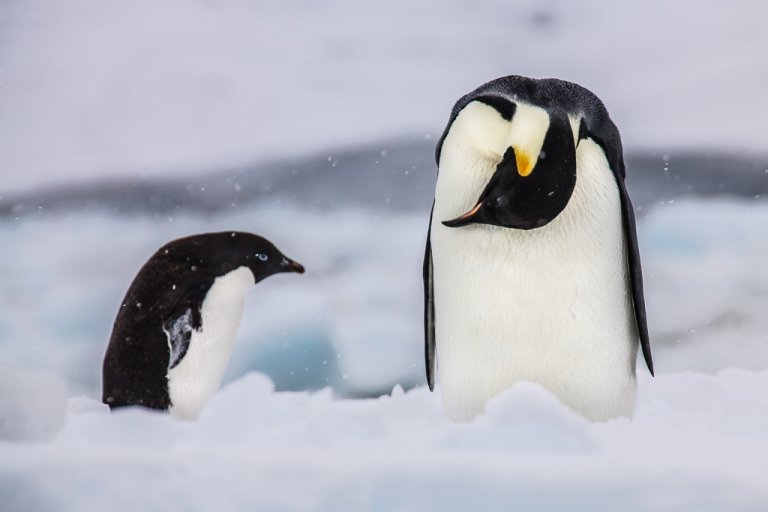
Antarctica Travel Guide
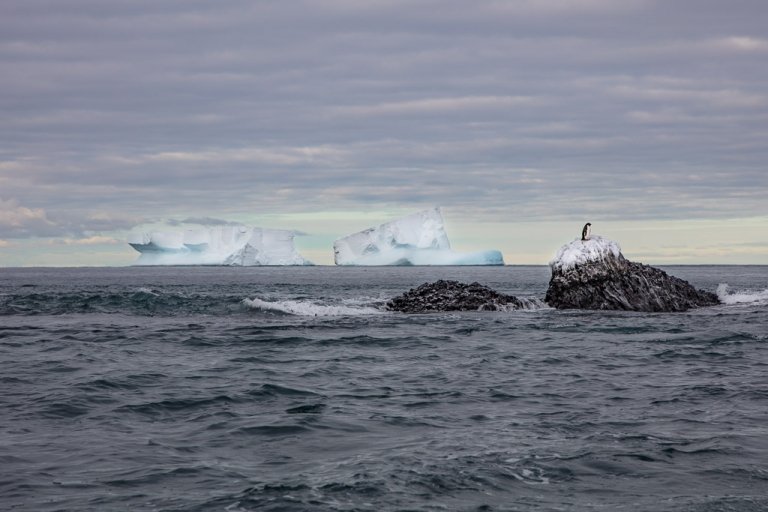
Franklin Island: Ice Glazed Volcanoes On The Fringe Of Antarctica
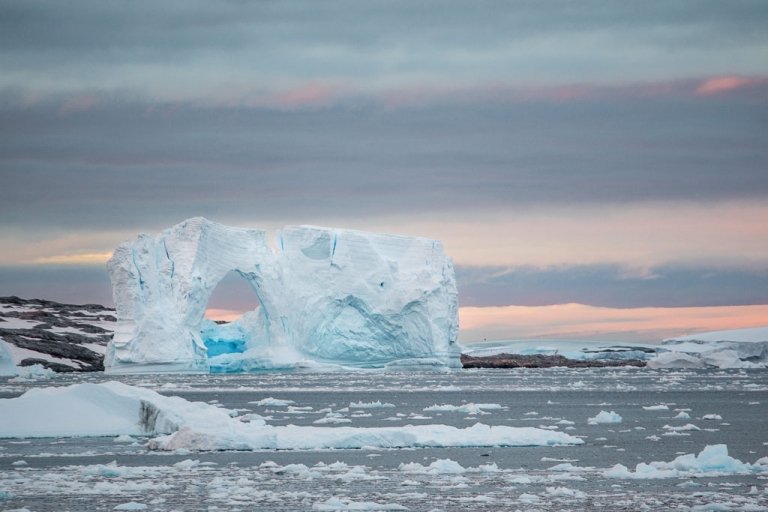
10 Reasons To Visit Antarctica
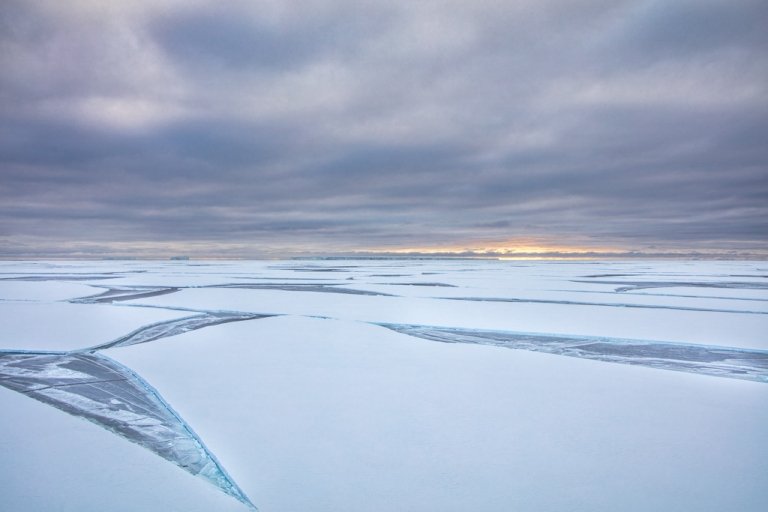
10 Reasons To Visit The Ross Sea
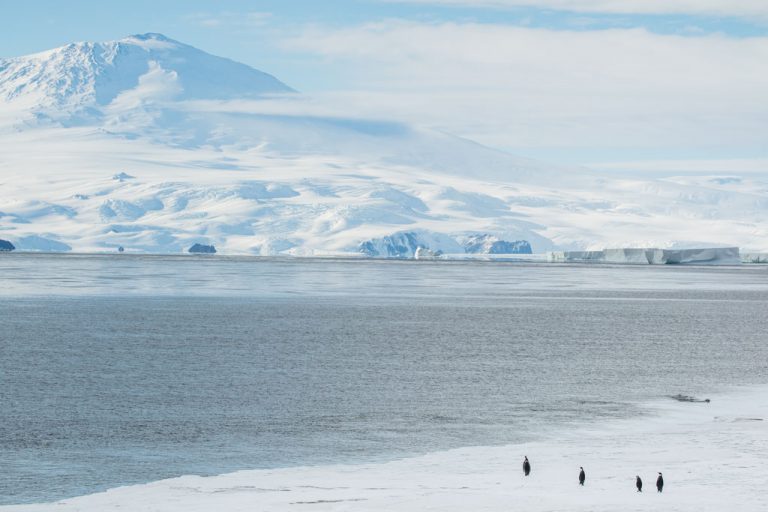
Sailing The Lemaire Channel
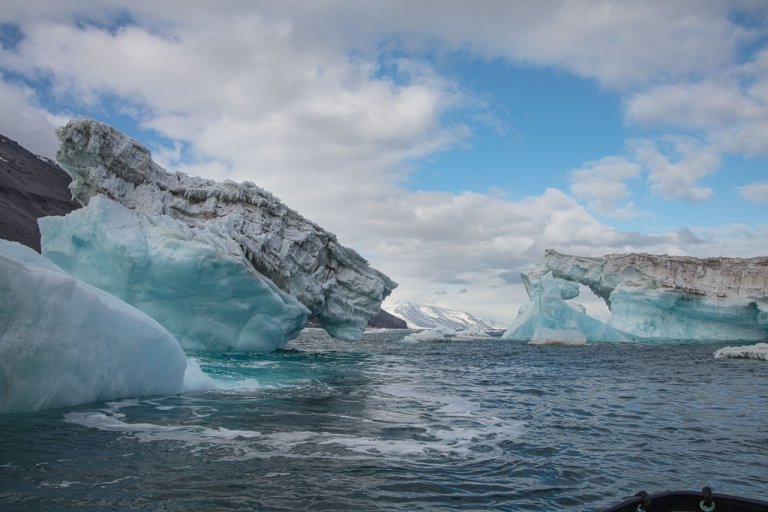
Preparing for Antarctica
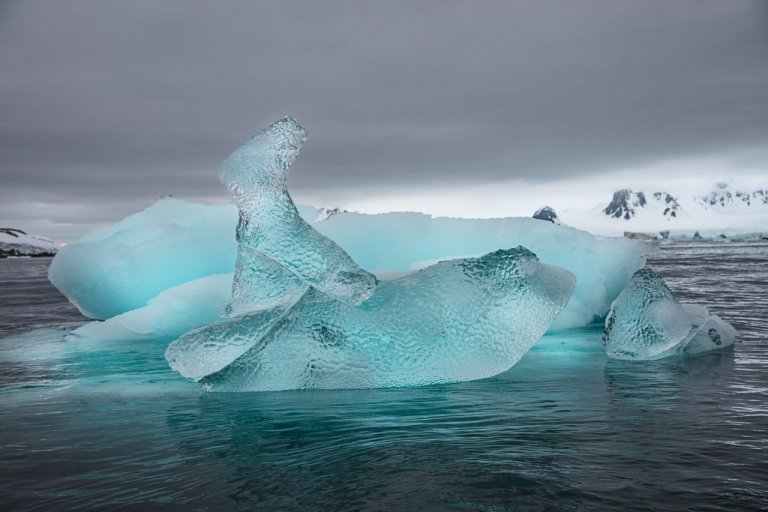
I’m going to Antarctica!
Leave a comment cancel reply.
Your email address will not be published. Required fields are marked *
Notify me of followup comments via e-mail. You can also subscribe without commenting.
This site uses Akismet to reduce spam. Learn how your comment data is processed .

Suggested Searches
- Climate Change
- Expedition 64
- Mars perseverance
- SpaceX Crew-2
- International Space Station
- View All Topics A-Z
Humans in Space
Earth & climate, the solar system, the universe, aeronautics, learning resources, news & events.

NASA Invites Social Creators for Launch of NOAA Weather Satellite

NASA’s New Mobile Launcher Stacks Up for Future Artemis Missions

NASA’s Webb Hints at Possible Atmosphere Surrounding Rocky Exoplanet
- Search All NASA Missions
- A to Z List of Missions
- Upcoming Launches and Landings
- Spaceships and Rockets
- Communicating with Missions
- James Webb Space Telescope
- Hubble Space Telescope
- Why Go to Space
Astronauts Home
- Commercial Space
- Destinations
- Living in Space
- Explore Earth Science
- Earth, Our Planet
- Earth Science in Action
- Earth Multimedia
- Earth Science Researchers
- Pluto & Dwarf Planets
- Asteroids, Comets & Meteors
- The Kuiper Belt
- The Oort Cloud
- Skywatching
- The Search for Life in the Universe
- Black Holes
- The Big Bang
- Dark Energy & Dark Matter
- Earth Science
- Planetary Science
- Astrophysics & Space Science
- The Sun & Heliophysics
- Biological & Physical Sciences
- Lunar Science
- Citizen Science
- Astromaterials
- Aeronautics Research
- Human Space Travel Research
- Science in the Air
- NASA Aircraft
- Flight Innovation
- Supersonic Flight
- Air Traffic Solutions
- Green Aviation Tech
- Drones & You
- Technology Transfer & Spinoffs
- Space Travel Technology
- Technology Living in Space
- Manufacturing and Materials
- Science Instruments
- For Kids and Students
- For Educators
- For Colleges and Universities
- For Professionals
- Science for Everyone
- Requests for Exhibits, Artifacts, or Speakers
- STEM Engagement at NASA
- NASA's Impacts
- Centers and Facilities
- Directorates
- Organizations
- People of NASA
- Internships
- Our History
- Doing Business with NASA
- Get Involved
- Aeronáutica
- Ciencias Terrestres
- Sistema Solar
- All NASA News
- Video Series on NASA+
- Newsletters
- Social Media
- Media Resources
- Upcoming Launches & Landings
- Virtual Events
- Sounds and Ringtones
- Interactives
- STEM Multimedia

Hubble Celebrates the 15th Anniversary of Servicing Mission 4

Hubble Glimpses a Star-Forming Factory

NASA Mission Strengthens 40-Year Friendship

NASA Selects Commercial Service Studies to Enable Mars Robotic Science

NASA’s Commercial Partners Deliver Cargo, Crew for Station Science

International SWOT Mission Can Improve Flood Prediction

NASA Is Helping Protect Tigers, Jaguars, and Elephants. Here’s How.

Two Small NASA Satellites Will Measure Soil Moisture, Volcanic Gases

C.26 Rapid Mission Design Studies for Mars Sample Return Correction and Other Documents Posted

NASA Selects Students for Europa Clipper Intern Program


The Big Event, 2024

NASA Images Help Explain Eating Habits of Massive Black Hole

NASA Licenses 3D-Printable Superalloy to Benefit US Economy

ARMD Solicitations

NASA’s Commitment to Safety Starts with its Culture

Tech Today: NASA’s Ion Thruster Knowhow Keeps Satellites Flying

Big Science Drives Wallops’ Upgrades for NASA Suborbital Missions

NASA Challenge Gives Artemis Generation Coders a Chance to Shine

NASA Community College Aerospace Scholars

Johnson Celebrates AA and NHPI Heritage Month: Kimia Seyedmadani

20 Years Ago: NASA Selects its 19th Group of Astronauts

Diez maneras en que los estudiantes pueden prepararse para ser astronautas

Astronauta de la NASA Marcos Berríos

Resultados científicos revolucionarios en la estación espacial de 2023
Antarctic stations.
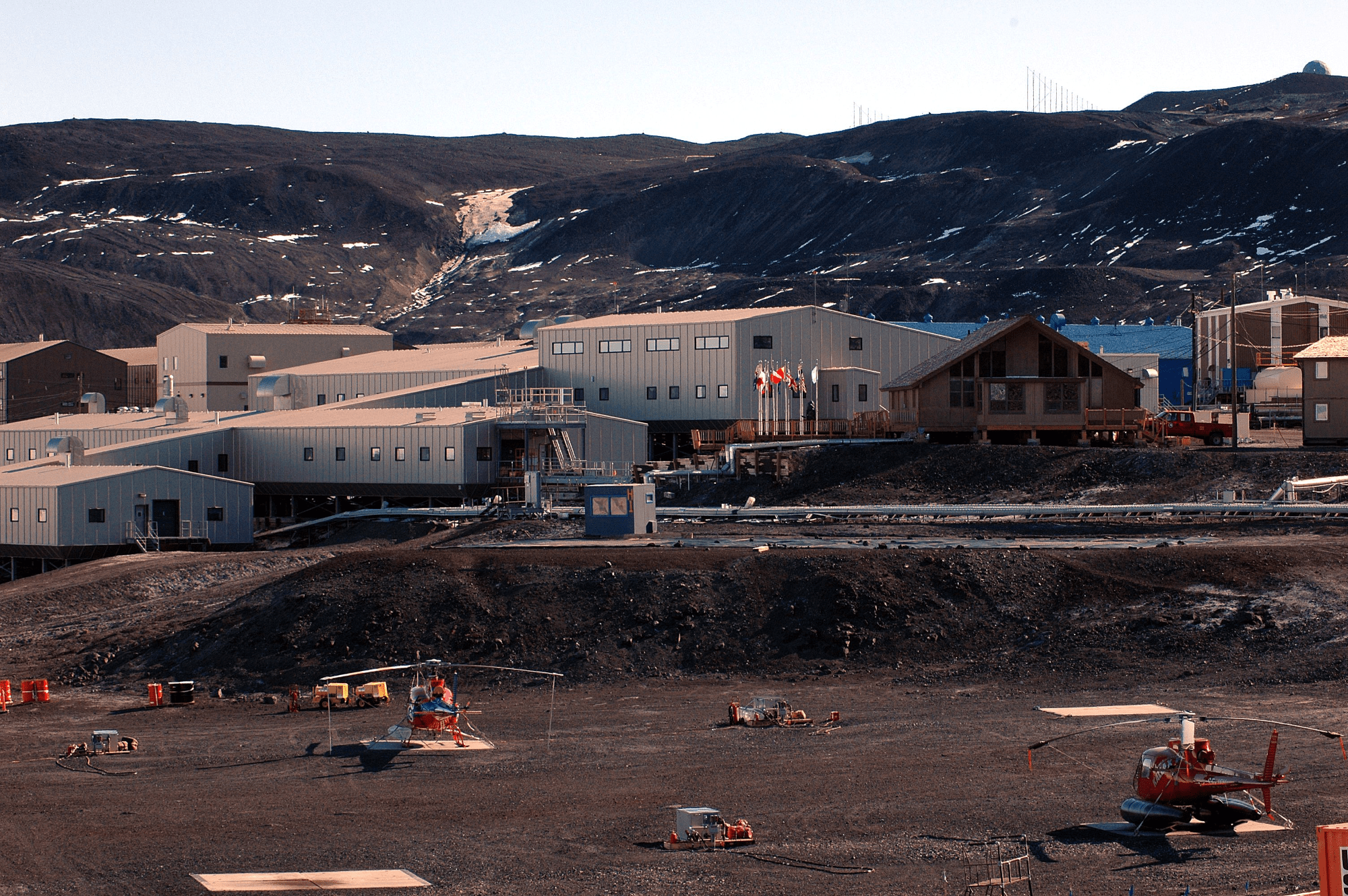
Mission Overview
- Location: Antarctica
- Environment: Isolation
- Hazards Tested: Hostile environment, isolation
Research Updates
- Team Dynamics Research
On October 25, 2019, two Human Research Program funded studies completed their final data collection sessions for the 2019 winter-over period at the National Science Foundation’s (NSF) McMurdo and Amundsen-Scott (South Pole) stations. These two studies were integrated into a single study protocol with procedures and measures shared between the two investigations. The final sample consisted of a total of 24 subjects, with 4 subjects at South Pole station and 20 subjects at McMurdo station, participating in the period from April to October 2019.
One study, Shared Cognitive Architectures for Long-term Exploration (SCALE), explored how social relations and team cognition are affected by isolation and confinement. This research may help enable teams to maintain and improve recall of shared knowledge and have a better understanding of the consequences of poor team performance.
A companion study to SCALE is titled Crew Recommender for Effective Work in Space (CREWS). This study uses the research data for developing a computer model that can help select the best crew team.
- Two New Immunology Studies Accepted for Antarctica Winter-Over 2020
The National Science Foundation (NSF) has accepted two immunology-focused studies for this upcoming winter-over season. Winter-over in Antarctica is roughly March through October. The first, led by Dr. Brian Crucian, will examine immunological response of subjects at the Palmer coastal station, focusing on similarities to responses seen in astronauts onboard the International Space Station (ISS). The second, led Dr. Satish Mehta, will study the effectiveness of preventative measures to suppress viral reactivation in subjects at McMurdo and Amundsen-Scott (South Pole) stations. Next steps include subject recruitment, personnel training, and logistics (e.g., shipping of consumables and medications).
The United States’ Antarctic Program (USAP) maintains McMurdo. Scientists believe that Antarctica’s climate, terrain, temperature, and isolation provide an environment on Earth that most closely parallels the conditions of isolation and stress to be faced on long-duration human missions in space. This analog provides a unique and accessible test bed to develop prototype systems and technologies for use on the Moon and Mars.
Learn More: http://www.nsf.gov/geo/plr/sitemap.jsp
Of the three U.S. Antarctic stations, Palmer is the only one that is accessed routinely during the winter. This station has a well-equipped laboratory and provides the opportunity for study of Biological, Ornithological, Meteorological, Atmospheric, Glaciological and Marine Ecosystem science.
ANSMET is a program funded by the National Science Foundation that looks for meteorites in the Transantarctic Mountains. This geographical area serves as a collection point for meteorites that have originally fallen on the extensive high-altitude ice fields throughout Antarctica.
Learn More: http://caslabs.case.edu/ansmet/
Explore More
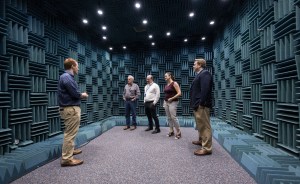
NASA Shares Lessons of Human Systems Integration with Industry

NASA Selects New Crew for Next Simulated Mars Journey

NASA Shares Medical Expertise with New Space Station Partners
Discover more topics from nasa.
Humans In Space

Space Station Research and Technology


- Antarctic Circle
- Antarctica Facts
- Antarctica from Australia and New Zealand
- South Georgia
- Falkland Islands
- Canadian Arctic
- Russian Arctic and North Pole
- Spitsbergen
- Belize & Guatemala
- Honduras & Nicaragua
- Panama & Costa Rica
- Machu Picchu
- Pantanal & Wetlands
- Photography
- Travel Tips
- Wine and Dine
- Sustainable Travel
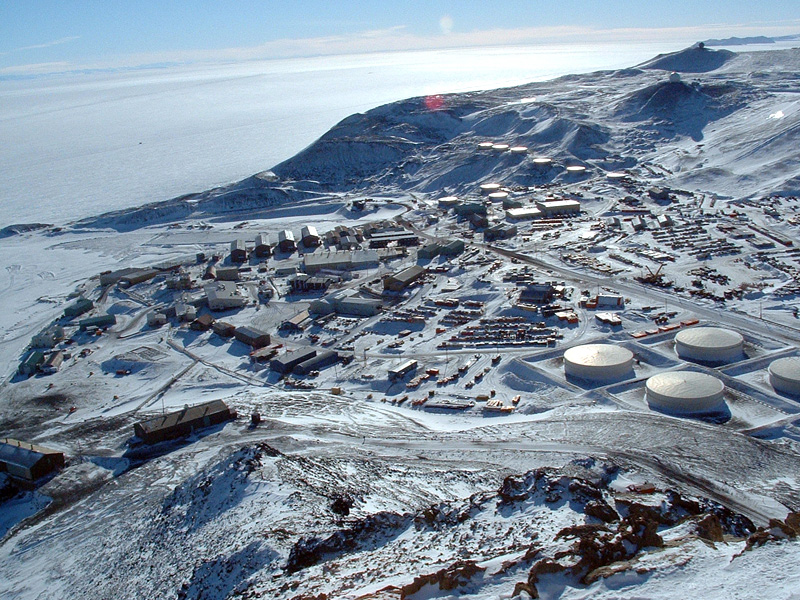
McMurdo Station, Antarctica: a Mighty Fine Place to go for a Drink
Often dubbed ‘the final hint of civilization’ on the southernmost end of the world, McMurdo Station is a US-run scientific research station in Antarctica. The largest encampment of its kind is also the last accessible place on the White Continent one can reach by ship.
Home to about 1,200 summer residents and 250 hardy folks who brave the winter harshness every year, McMurdo is a true ‘small city’ by all intents and purposes. It boasts a chapel, several ATMs, a golf course, three plane landing strips, a fire station, post office, and two bars.
Granted, McMurdo Station is a long way to go for a drink, yet a visit is one of the highlights for many of our guests on cruises to Antarctica . Renowned for attracting an utterly diverse bunch of people, McMurdo is arguably one of the most fascinating towns you could visit. And considering getting there is an adventure in itself, a stiff drink upon arrival may be just the reward you’ll need!
What is McMurdo Station all about?
McMurdo Station is part of Operation Deep Freeze, the American Antarctic missions which began in the 1950s. Run by the United States Antarctic Program (USAP) , the operation includes all the US stations on the White Continent, as well as all the restocking missions needed to keep them running. The primary objective of McMurdo is scientific research, and expert researchers work in fields of biology, chemistry, and astronomy primarily. They are geologists and glaciologists, physicists, oceanologists and almost every other type of ‘-ologists’ known to man.
Everything is researched here: from climate change to Antarctic wildlife, the shifting of ice shelves and all else which may help us better understand this most enigmatic part of the world. Tens of thousands of polar diving expeditions have taken place here in the last two decades alone, and McMurdo acts as the last support base for extreme scientific research missions further afield.
Whilst the great part of the research work is carried out during the more ‘bearable’ summer months’, McMurdo in winter is mostly inhabited by civilians whose sole mission is to keep the whole town – which includes a hundred or so buildings – in perfect working condition.
Life on McMurdo Station
Much like every other destination on the planet, McMurdo also boasts high and low seasons! In summer, when the sun never sets and the temperature can even creep above a balmy 0 degrees Celsius, the town hosts a booming population. You know, relatively speaking.
In winter, however, when darkness prevails and freezing doesn’t even begin to describe the temps, only a few hundred hard-core residents remain. Contracted scientists, researchers, and civilians mostly work on a rotational basis, ranging from 1 to 3 months. The great majority who work here are actually civilians, who are in charge of keeping the whole shebang operational. Along with the researchers, this amazing bunch of adventurous cooks, builders, electrician plumbers, truck drivers, and technicians make for one amalgamous ‘family’. They hail from all over the globe, and all share a common desire to work and live in a place that’s both mesmerizing and incredibly unforgiving.
Life here is both mundane and extraordinary. Residents hold art exhibitions, head to the pub to hear live music and partake in marathons. They organize trivia nights, sporting events and even held the sole protest in Antarctica against the invasion of Iraq by US troops, back in 2003.
Antarctica is often described as an addictive place. Its magnetic pull, the dramatic beauty of its landscape, incredible wildlife and surreal experience means there are few who visit only once. McMurdo station is no exception. Many of the residents and scientists working and living here come back year after year. Some for decades on end. The collective time spent at McMurdo is locally referred to as ‘ice time’, something of which all are very proud to boast.
Their dedication to keeping the station running smoothly, and their personal desire to live a life a little less ordinary, is the driving force behind many people’s near-obsession with McMurdo.
If you’re as fascinated as we are by this amazing place and the people who inhabit it, check out Encounters at the End of the World , an interesting documentary by famed German film-maker Werner Herzog, which portrays everyday life at McMurdo and the colourful characters who call this place home.
The mind-boggling logistics that keep McMurdo Station running
Sitting on the lounge at home, it’s easy to take things for granted. You open the tap and fresh drinking water comes out. You pop up to the corner store for supplies, and just about everything you need to survive is always at your fingertips.
Not so much in Antarctica, the only continent where nothing grows naturally. Everything needed for living at McMurdo needs to be shipped in on cargo ships, with periodic restocking flights by DC10 and LC-130 Hercules picking up the slack every year. Millions of litres of fuel and tonnes upon tonnes of supplies are brought in every year to keep this mission alive and well, and an equally impressive amount of waste is brought back to the US from McMurdo.
Almost one-third of the electricity used at the station is wind-produced, and more than 170,000 litres of fresh drinking water that are needed every single day, are desalinated on-site. People living at McMurdo station are, perhaps more than anybody else, acutely aware of the environmental impact each human being makes on our planet simply by ‘existing’. Minimizing their own impact in Antarctica – and rationing just about everything – is the way of life down here.
Restocking of McMurdo during operation Deep Freeze in 2007. Photo credit: Wikipedia.
Where is McMurdo Station & can you visit?
McMurdo Station shares island space with the New Zealand Antarctic Mission (a mere fraction of its size), found on the southernmost tip of Ross Island, in the heart of the spectacular Ross Sea. This is where you’ll also find Mt Erebus, the southernmost active volcano on earth.
Social visits to McMurdo Station are not exactly unheard of yet permission is rarely granted. Looking for a totally out-of-the-box experience? Then head there to work! By all accounts, the pay is meagre and you get to shovel a lot of snow, but if you’re craving a change of pace, dare we say you may have just found it. It’s not surprising to learn that every year, there are infinitely more applicants than job availability, yet with a bit of perseverance and a clean bill of health there’s no reason why you shouldn’t give it a good go. Generally speaking it is easier to get a job working for the Antarctic research centre of your home country, as that’s where interviews will take place.
But we have an even better option for you. Why not join us on an Antarctica expedition cruise to the spectacular Ross Sea?
This is one of the least-visited and most beautiful parts of the southern continent. On a voyage aboard an expedition vessel, you’ll not only get to see an insane amount of wildlife – including penguins, sea lions, an infinite number of endemic birds, and even whales – but you’ll finally have that end-of-the-world experience to which all McMurdo Station residents are totally addicted.
Awe-inspiring and unforgettable, a cruise to Antarctica is a bucket-list adventure everyone should experience at least once in life. We can also include visits to ‘easier to access’ research stations so you can get an insider’s view at the incredible work being done in our planet’s most enigmatic continent.


McMurdo Station Packing List for Working in Antarctica

A general McMurdo Station packing list is essential for anyone going to work in Antarctica for the first time.
While everyone’s list will be slightly different depending on your job, this post will cover the basic things you’ll want to bring based on my experience working in McMurdo .
Weight and Baggage Allowance

There are two things to keep in mind: commercial flight luggage/weight restrictions and the weight limit for the ice flight (Christchurch to McMurdo).
Commercial flights will allow you to check in two, 50 lb bags.
However, you’ll only be allowed to bring 85 lbs of checked luggage with you onto the ice flight.
This will include around 10 lbs of your mandatory extreme cold weather (ECW) gear.
View this post on Instagram A post shared by Michelle | Work + Travel (@wandereatwrite)
If you are working in the kitchen and/or will be given uniform to wear as well, expect to save a few extra pounds for this.
So, this will turn out to be 70-75 lbs of your own luggage + ~10 lbs reserved for ECW/uniform.
Additionally, you can bring up to 15 lbs of carry-on, and this does not count toward the 85 lbs of checked luggage.
Tip: There is a small storage area on station as well as bins in every dorm called Skua (named after the bird) where you can find used clothing and goods that others have left behind.
While you won’t find everything you need there, chances are that if you’re in need of a shirt or sweater during your contract, you’ll be able to find something in Skua.
Related: 20 Things You Didn’t Know About Life at McMurdo Station, Antarctica
Get Your FREE eBook Now!
By providing your details, you consent to receiving our emails. Unsubscribe any time.
Clothing Packing List
In addition to the Big Red parka that’s issued to you, you’ll want to bring your own jacket that’s not as bulky.
There are days where the Big Red will actually be too warm to wear around, so less intense outerwear will be more comfortable.
This is the jacket I brought down with me that worked out well.
Waterproof Pants
Again, you’ll get a set of overall snow bibs as part of your ECW, and again, you’ll almost never wear them.
If your job requires you to be outdoors, you might want to bring a few sets of warm, waterproof snow pants.
I loved the pair I brought because it was fleece-lined and lightweight yet roomy enough to wear over leggings.
Long Thermal Underwear/ Fleece-Lined Everything
Non-cotton materials for base layers are recommended, such as polyester or merino wool.
While the packing list USAP provides suggests bringing both lightweight and mid-weight base layers , I found that lightweight layers were sufficient for me as someone who worked indoors and occasionally went on hikes.
The best decision I made was bringing literally fleece-lined everything: leggings , thermal tops , a beanie , and snow pants as previously mentioned.
Regular Clothes + Loungewear
Be sure to pack a mix of normal everyday clothes like t-shirts, sweaters, and jeans.
While it is cold in Antarctica, it’s not often as cold as you’d expect, and you’ll be spending the majority of your off-time indoors anyway.
For lazy days, don’t forget your favorite pair of joggers or sweatpants. Especially since there are a few weeks of managed isolation in hotels for the 2021-2022 season, you’ll definitely want to have your comfiest pandemic loungewear attire.
Related: Life at the South Pole Station: Everything You Want to Know

Warm Winter Socks
Merino wool socks are definitely a must to keep you warm, especially if you work outside.
As a stewie, I only brought a few pairs of thick, warm socks just for the days I spent several hours outdoors or for hikes.
Again for indoor staff, you won’t want to wear super warm socks for work.
Regular socks are fine. But for kitchen workers, bringing a few more extra pairs than you think you’ll need is probably a good idea.
You’re bound to rip a hole or lose a few in the laundry room (especially if someone gets to your washer or dryer before you and isn’t so thorough in taking your clothes out).
You’ll want to have a few backups on hand.
Same goes for underwear: bring extra.
Why? It’s not like you can easily buy more while on station; and also, disturbingly, there are people who will steal your underwear.
(Typically only among men. I really have no idea why, but I heard this happen to more than one guy the last time I was there.)
Gym Clothes + Shoes
If you plan on working out or doing any sports while in McMurdo, pack some gym clothes and appropriate shoes.
I’d definitely suggest packing the bare minimum of workout t-shirts and tanks as there’s always an abundance of these in Skua if you’re not picky.
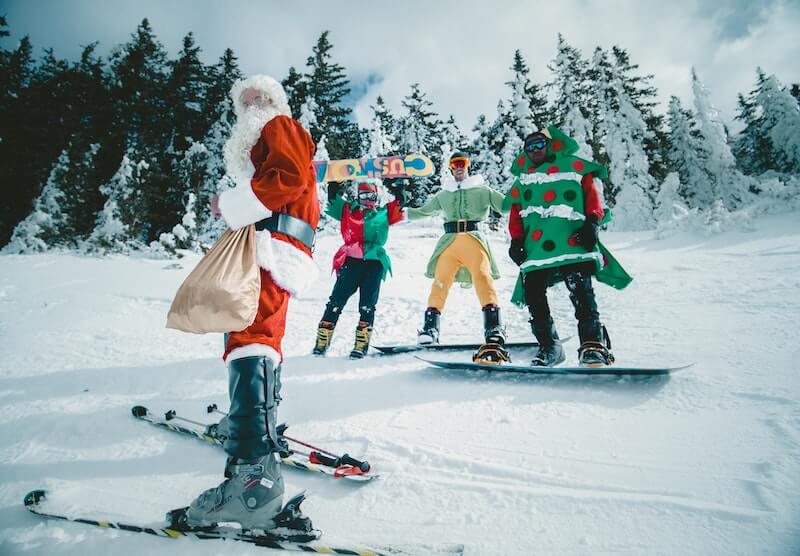
If you ask anyone on Reddit what to pack for a season in Antarctica, the most common answer is almost always to bring less regular clothing and more costumes, because McMurdo.
There’s no event or party where a costume is not appropriate on station. Be prepared for lots of middle-aged adults in onesies .
Keep in mind that if you don’t bring a costume down and want to join in on the merriment, there’s always Skua.
Holiday Outfit
There are several times on station when people like to get a little more dressed up than usual, especially Christmas.
It’s not mandatory and not everyone takes part, but if you have extra room in your luggage and you like getting festive, bring one nice outfit. (Don’t bother packing more than one.)
Accessories
• Fleece-lined beanie and/or headwrap
• Gloves : You’ll be issued a bulky leather pair and one thinner set of gloves, but I preferred to bring my own pair that didn’t require me to take them off to use my phone or GoPro ‘s touchscreen.
• Sunglasses: You do not want to be in Antarctica without a pair of good sunglasses with UV protection . The 24/7 daylight in the summer and reflection from the ice can make the outdoors very bright. You might even consider bringing a backup pair just in case.
Related: How I Got Paid to Live in Antarctica: FAQ About Working on the Ice
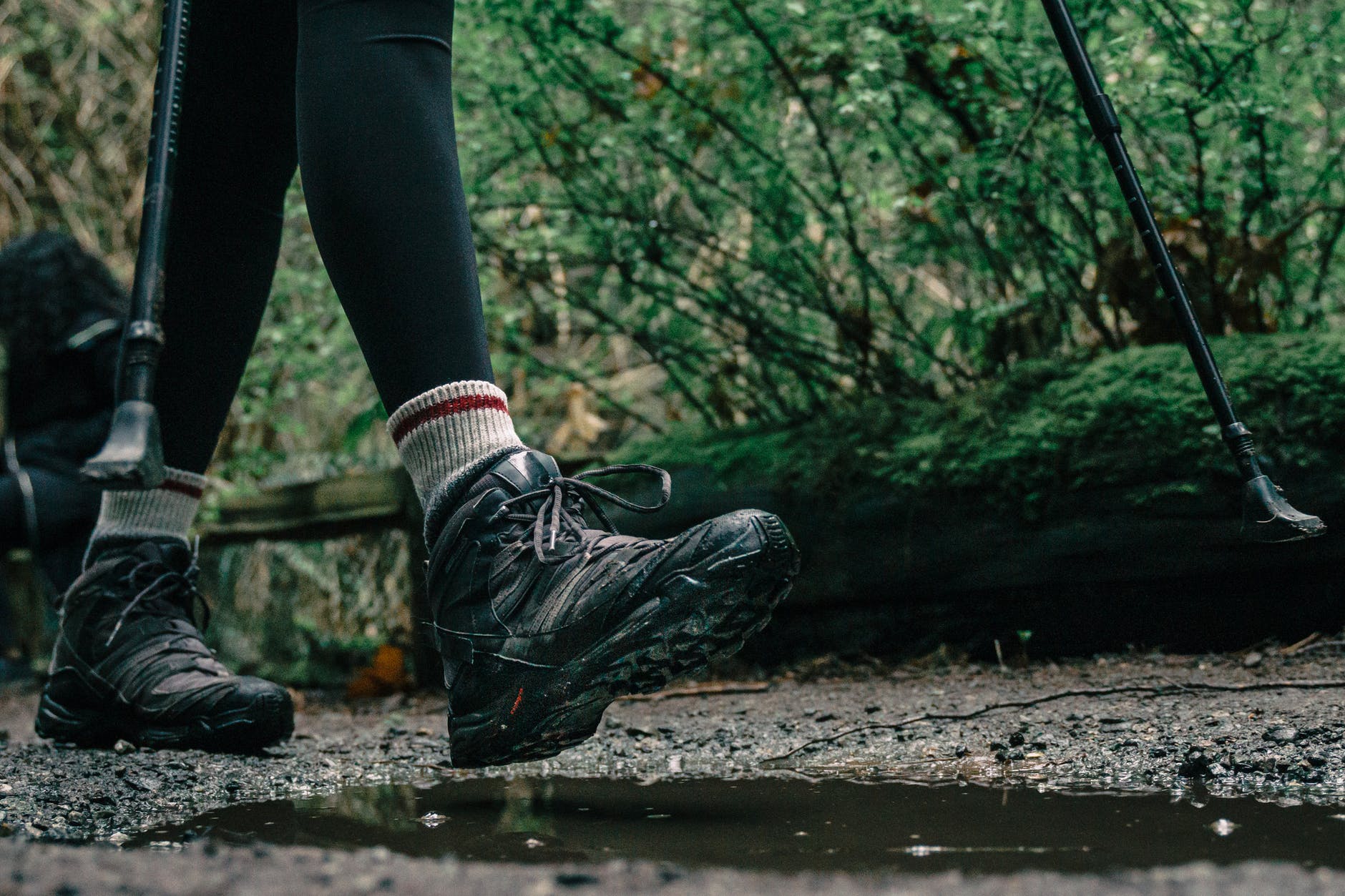
Hiking Boots
You’ll be issued what are called “bunny boots” as part of your mandatory ECW, but like all the other mandatory gear, you’ll probably never wear them except when you’re flying in and off the continent.
Bringing your own set of hiking boots is more practical and comfortable.
I brought a pair of lightweight Columbia boots which worked out perfectly for hiking the trails around McMurdo.
If your job requires you to work outdoors, you’ll most likely want to pack warmer and more weather-resistant boots .
For more details about recommended footwear for work and recreation, check out my post about the best boots for Antarctica .
Casual Shoes
Bring regular shoes to wear in your downtime.
You won’t be working all the time and you probably won’t want to always wear hiking boots just hanging out at the bar or walking between buildings.
Shower Sandals
Shower sandals are a must, especially if you end up dorming in Building 155 with communal bathrooms, which is most likely if it’s your first season on the ice.
It’s really a personal preference, but even in the shared suites, I’d still bring some sort of fast-drying sandals or flip-flops.
Non-Slip Shoes for Kitchen Staff
While uniforms are provided for kitchen stewards and staff, you will need to bring your own pair of black, non-slip work shoes .
If you’re staying for an entire year, you might even want to bring a backup pair.
Tip for stewards: Try to avoid shoes with mesh lining on the outside if you can. I wore these my first season and while it wasn’t a major issue, they did get wet very easily while washing dishes and I’d often end up with wet socks for a whole shift.
Related: Working in Antarctica: Supply Tech Jim Huston | Stories from the Ice
Non-Clothing Packing List

Bedding and Pillow
Sheets, blankets, and pillows are provided, but many people prefer to bring their own as some of the ones on station are well used.
I have a set of lightweight yet cozy sheets (twin xl) and even a blanket that I always bring with me to my ship contracts and was very happy to bring them down to the ice as well.
I personally didn’t feel like I needed to bring my own pillow, but I’m not too particular on that front.
Things to Decorate Your Room and Walls With
Combined with the isolated environment, I found that the dorms felt very sterile and not at all comforting, so covering up those depressing walls is definitely a must for me.
Common recommended items are twinkle lights , photos, and wall tapestries .
Diffuser + Essential Oils
I don’t think bringing a diffuser and essential oils are that popular, but I did and didn’t regret it.
It tripled as a calming fragrance source (candles aren’t allowed), humidifier, and nightlight.
Bathroom + Toiletries

The station store will have basics like toothpaste, soap, and shampoo/conditioner.
The following are some additional things you might want to pack for McMurdo.
Lotion and Moisturizers
Antarctica is extremely dry, and while the station store will carry some lotions , it might not be enough.
If you use any form of facial moisturizers , bring more than you think you’ll need because the store does not carry anything other than general body lotion.
The sun is no joke on the ice so you’ll want to wear sunscreen if you’re outside for an extended period.
The store does have some sunscreen for sale, but as with all things, if you have a preferred brand– bring your own.
The station does not provide towels (although you might be able to find one in Skua, but gross) so be sure to bring your own.
I brought my trusty set of quick-drying travel towels and it saved me so much space in addition to drying super fast so it didn’t stink up the room.
Shower Caddy
Showers in the largest dorm are communal so a small basket or easy-to-pack shower caddy will come in handy.
Another personal preference thing, but I brought my travel hair dryer since I have long hair and hate waiting for it to air dry.
Mesh Laundry Bag
As I mentioned, there’s a very good chance that someone will move your clothes to or out of the dryer if you don’t get there on time.
I’ve accepted this, but I also don’t like people touching my underwear, so I throw them in a mesh laundry bag .
They’re also great for ensuring that you don’t lose any socks in transit.
Menstrual Products
There are some products available at the store but again, it’s very limited.
A reusable menstrual cup is a great way to keep costs, luggage space, and waste down if it works comfortably for you.
Motion Sickness Medication
If you’re easily prone to motion sickness like myself, don’t forget to pack some motion sickness medication .
The ice flight down to McMurdo should be fine, but the ride from the airfield to McMurdo Station could be choppy.
This is especially true if you end up getting transported on the larger vehicles such as the Kress (big long red truck) or Ivan (giant orange bus).
If you have dry eyes or wear contact lenses, definitely bring a few bottles of your preferred eye drops down as the lack of moisture in the air only exacerbates issues.
If you’re like me and have severely dry eyes, regular drops will not be heavy-duty enough.
At the advice of my optometrist, I brought eye gel drops for use during the day and a lubricating eye ointment at night and I’m pretty sure they’re the only reason why my eyes didn’t experience any irritation or vision issues during my contract.
Related: 5 Tips to Alleviate Dry Eyes While Traveling
Electronics

Ethernet Adapter
There’s no Wi-Fi during mainbody (summer season), so the only way to connect your laptop to the internet is with an ethernet cable.
If your laptop doesn’t have an ethernet port, you’ll need to bring an adapter with you.
External Hard Drive + Entertainment
An external hard drive allows you to bring as much digital entertainment as you want, which is also highly recommended.
Download as much music and as many movies, TV shows, and podcasts as you can before flying to the ice as you won’t have access to streaming services on the ice.
Universal Adapter
While you don’t need an adapter on station, you will need one during your time in transit or COVID-managed isolation in New Zealand.
Camera + Accessories
You don’t want to regret not bringing a great camera down with you!
A contract on the ice is a once-in-a-lifetime experience and you’ll see so many unique landscapes and of course, penguins and other wildlife in their natural habitat.
If you have a newer phone , the camera might be good enough if you enjoy nature and photography casually.
However, if you want more professional or high-quality close-up shots of the wildlife, you might consider bringing a camera.
Additionally, if you’re wintering and want to get good photos of the Aurora Australis in Antarctica , a camera is a must as a phone won’t cut it.
Here are some good camera options for every budget:
- Canon EOS Rebel T7
- Panasonic LUMIX G7
- Sony Alpha A7R IV
I also brought a GoPro and used it frequently as the wide-angle provided some truly beautiful shots.
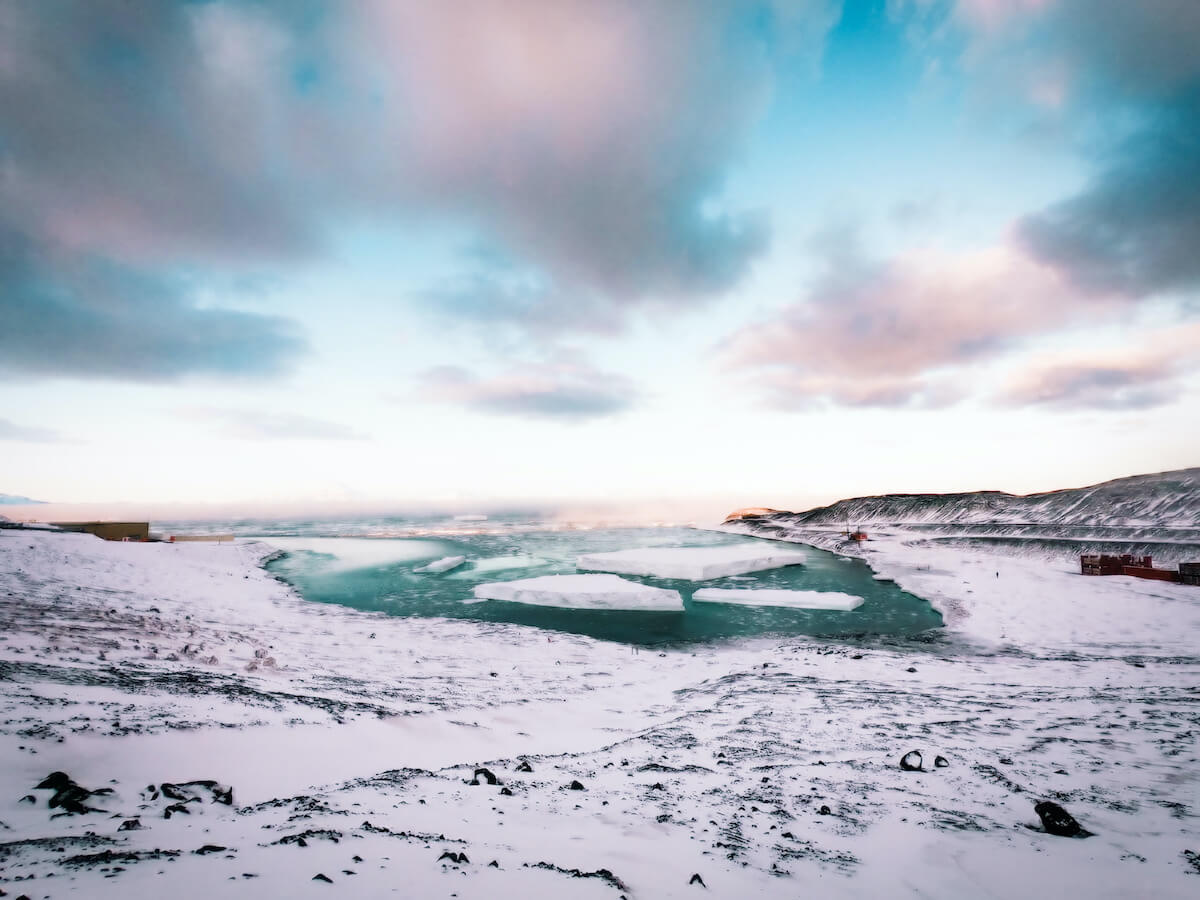
Tip: Bring extra batteries as the extreme cold can do weird things if you’re outside taking pictures for extended periods of time.
Noise Cancelling Headphones
Chances are you’ll be flying to McMurdo from Christchurch on either a C-17 or LC-130 Hercules, and it will be loudest flight you’ve ever flown on.
Unlike commercial flights, passenger comfort isn’t really the top priority.
You’ll be offered earplugs when you board, and I highly suggest you use them.
Noise cancelling headphones will also help make the journey more bearable.
Remember, you might be on the plane for up to 10 hours if the plane boomerangs (has to return to Christchurch while enroute to McMurdo) so you’ll want to be as comfortable as possible.
Snacks and Coffee/Tea

You’ll be away from a lot of your favorite snacks and treats for a while, so it’s worth it to sacrifice a bit of luggage space to bring some with you.
If you’re particular about your coffees or teas, definitely bring your own.
Tip: Get as much produce as you can in Christchurch to bring with you on the ice flight as they’ll probably be the last freshies you’ll have for several weeks, if not months.
Water Bottle + Travel Mug
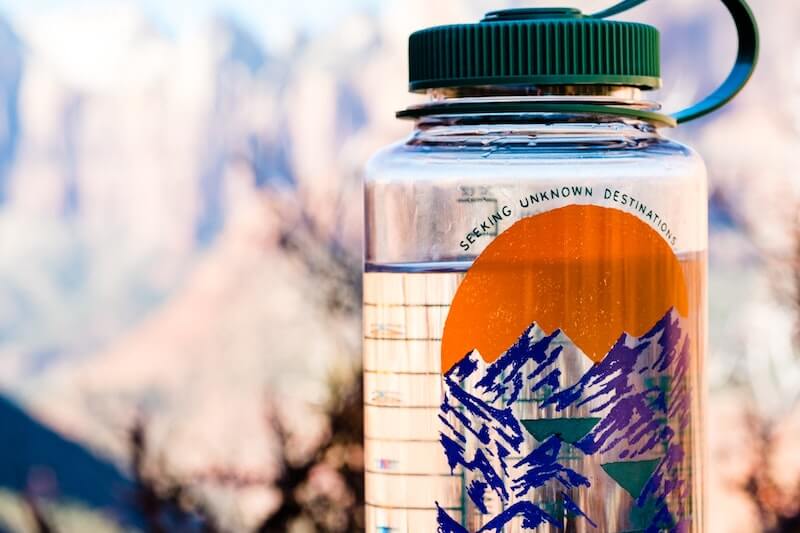
You’ll need to hydrate frequently in the dry environment, so bring a good water bottle that you can refill often and a travel mug to keep your coffees and teas warm.
Additional Antarctica Posts:
- How I Got Paid to Live in Antarctica: FAQ About Working on the Ice
- 20 Things You Didn’t Know About Life at McMurdo Station, Antarctica
Life at the South Pole Station: Everything You Want to Know
- Antarctica Northern Lights & Southern Lights Guide 2023
- Working in Antarctica: Supply Tech Jim Huston | Stories from the Ice
Working in Antarctica: Blaster Garry Rex | Stories From the Ice
- How to Get Paid to Travel to Every Continent (Yes, Even Antarctica)
Pin and Save
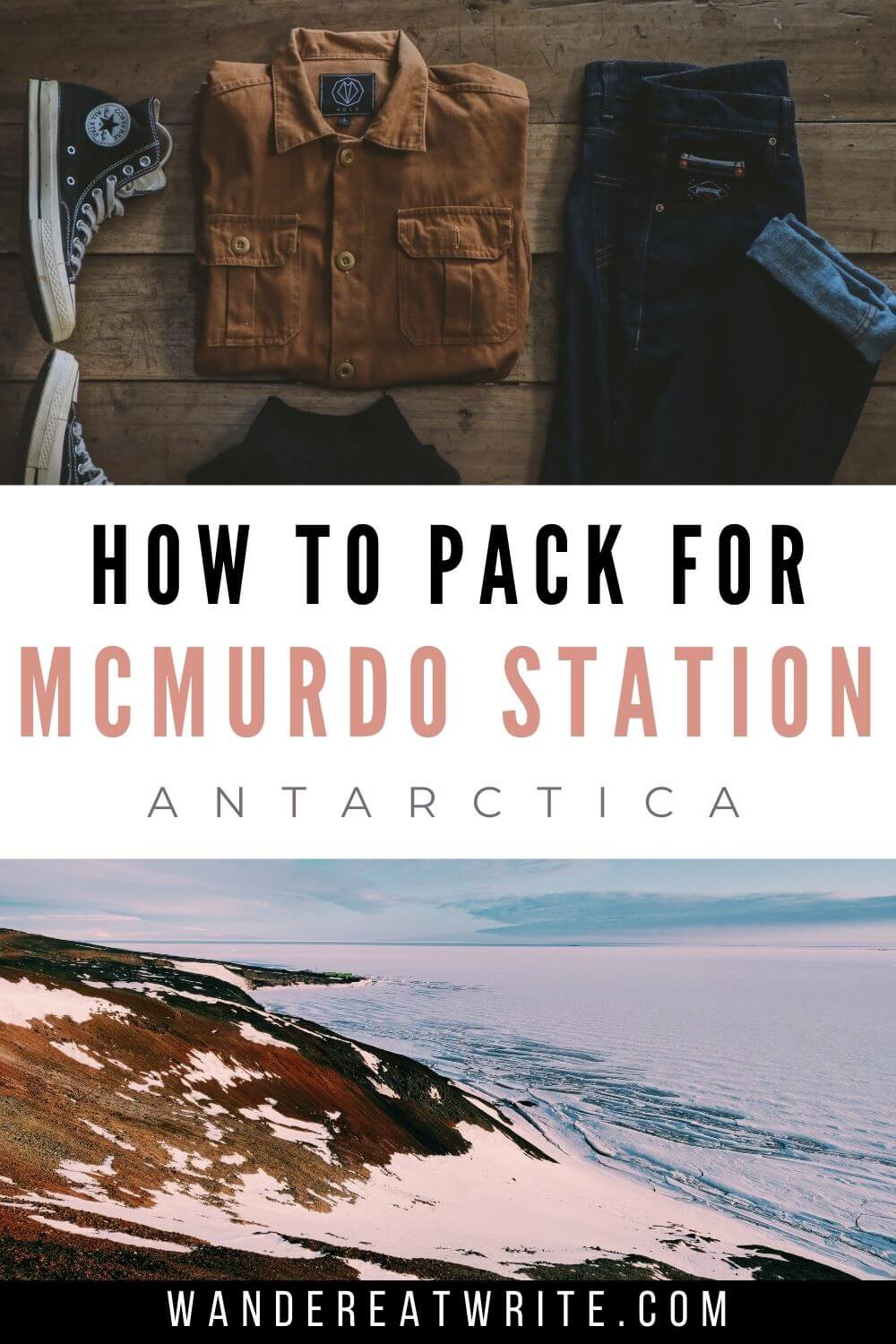
Michelle is a freelance writer who has traveled to all seven continents and 60+ countries through various forms of employment. Over the last ten years, she’s worked as an ESL teacher in Japan, a youth counselor aboard cruise ships, and a hospitality manager in Antarctica.
Related posts
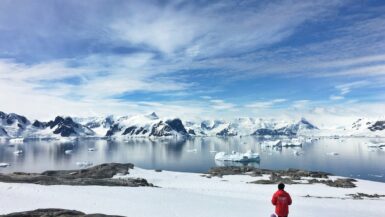
17 BEST Boots for Antarctica: Expert Tips from an Ice Veteran
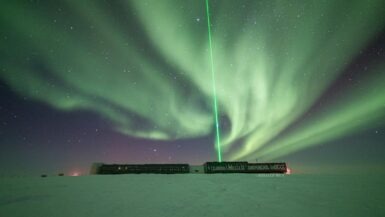
Antarctica Northern Lights & Southern Lights Guide 2023
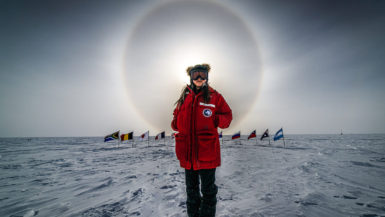
Leave a reply Cancel reply
Your email address will not be published. Required fields are marked *
You are such a good writer. I enjoy reading all of your blogs. Even tho I will prob nvr go to Antarctica or work on cruise ships, reading how informative you are, I can sit here and imagine myself on these travels. I kinda wish I knew of this years ago. Mayb I would have attempted to try these things. But I subscribed to your email and will continue to enjoy and imagine thru your writings. Idk, I’m also kinda proud of you for venturing out in the world at your age…. alone. I think its pretty cool.
Thank you for your kind words! It’s never too late to try something new or go somewhere you’ve always dreamed of :)
I traveled full time w a pack for 3 years, including time in the Arctic Circle, but working a season on the ice sent me on a packing list search just in case. So, thank you for publishing your Antarctica packing list. I’ve added a few things to my list!
I also have a dry eye issue. May I ask how many bottles of each of the drops you used?
Hi Valarie, that’s so cool! I hope you have an amazing time down in Antarctica.
I can’t remember exactly how many bottles of eye gel I brought down, but it was probably between 4-6. This was enough to last me the duration of my 4-month contract.
Hi there! Thank you so very much for your informative post. Just what I needed! I would like to ask, how long are contracts on McMurdo, do they accept people for contract Mid-summer, dorm rooms aren’t co-ed right?, is there a Catholic priest on base, can you make telephone calls, and is this considered a military contract?
Thank you again!!!
-Contract lengths can vary from just a few weeks to a full season to a year+. -At MCM, contracts are given nearly all year round, certainly all throughout summer. -Dorm rooms are only co-ed if specified/requested, although the dorm building will always be mixed. -There is a chaplain on base (usually nondenominational). -Phone calls just require a calling card (unless calling to a Denver number). -For most people at MCM, it is not a military contract. Only those sent down as part of their military assignment (flying the planes, working on the ice breaker, etc.) fall under military contracts
I googled ‘what to pack for mcmurdo’ on a whim thinking I would get some basic results, but was so pleasantly surprised by this genius list with helpful additional color. You’re a legend thanks!
Glad I could help! Best of luck on your contract.
Privacy Overview
Privacy Policy - Terms and Conditions

How To Fly To Antarctica By Private Jet
T here are no native human inhabitants in Antarctica, yet the continent receives thousands of visitors per year. Many of these visitors are scientists looking to conduct meteorological, wildlife, and astrophysical research. However, some of these visitors are travelers looking to explore the exotic land. In 2022, tourists outnumbered scientists by over 20 times, per Geographical .
Many of these tourists, and even many of the scientists, travel to Antarctica by boat. Alternatively, it is estimated that about 10% of the continent's visitors travel to Antarctica by plane, per Antarctica Guide . However, there are no commercial flights that operate to Antarctica . Therefore, many visitors must take chartered flights to the continent from either South America or Southern Africa. Let's take a closer look at how some travelers can fly to Antarctica.
Standard experiences
White Desert is one of the most well-known travel companies that run excursions to Antarctica. The company provides opportunities for both tourists and scientists from all over the world to reach the frozen continent. White Desert has several small, luxury camps in Antarcitca, and runs many adventures and excursions for visitors to enjoy.
These adventures include experiences such as the Early Emperors, which allows travelers to follow the early days of a penguin colony for up to five days, or a trip called the Greatest Day, where visitors can experience a unique day trip accompanied by a professional guide. Another adventure is called the White Desert World. This trip takes travelers to all seven continents by private plane across 21 total days and 10 stops.
White Desert also operates several aircraft to transport adventurers from other continents. One is the Airbus A340-300 with two classes, which can fly from Cape Town to Wolf Fang's Runway in under five hours. White Desert also flies a Gulfstream G550, which can fly round trip to Wolf Fang's Runway without refueling. The last aircraft that White Desert operates is a Basler BT-67. This aircraft has had more than $9 million invested in airframe upgrades and can land on both snow and ice.
Additionally, a travel experience creation company called Red Savannah offers Antarctica as a unique experience. Visitors travel to the continent by private plane which is also booked in partnership with White Desert. This nine-day adventure takes off from South Africa and allows travelers to visit emperor penguin colonies and stay in luxury campsites throughout the South Pole.
Chartered flights
Several airlines and charter companies offer guided trips to Antarctica. Lux Aviation , which is a Luxembourg-based private jet charter service, offers an experience called Midnight Sun. This experience takes up to eight guests from Cape Town and lands at Wolf's Fang runway in the Arctic. Guests can choose to accompany a guide and experience a wide range of activities on the continent in partnership with White Desert.
Additionally, Victor , a digital private jet charter, flies to several Antarctic locations. The charter licenses flights to McMurdo Station Pegasus Field (NZPG), McMurdo Station Ice Runway (NZIR), Williams Field (NZWD), Palmer Station Airport (NZ12), South Pole Station Airport (NZSP), Petrel Airport (SA47), Marambio Base (SAWB), and Teniente Rodolfo Marsh Martin Base (TNM).
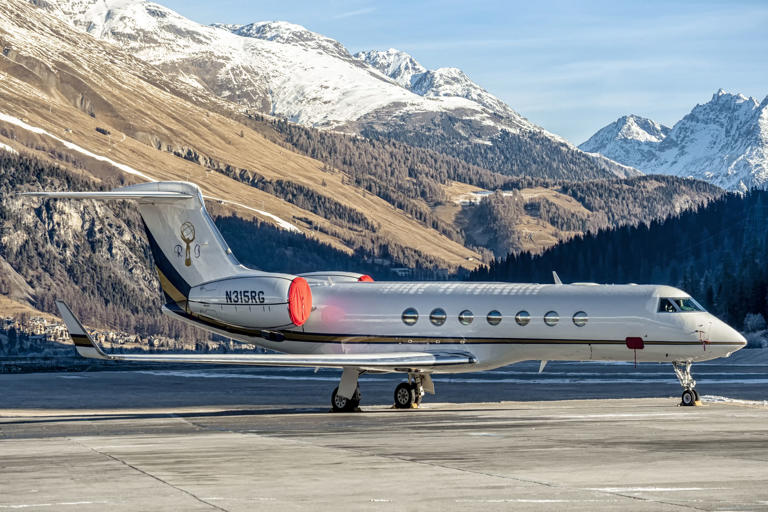

IMAGES
VIDEO
COMMENTS
McMurdo Station size and population. Built in 1955, McMurdo Station is the largest scientific research facility in Antarctica. It can support more than 1,200 people during the Southern Hemisphere summer, but in winter that population goes down to about 200 people. The size of McMurdo Station can make it feel more like a village than a base.
McMurdo Station. McMurdo Station (www.usap.gov, www.nsf.gov), Antarctica's largest encampment, has the feel of a bustling frontier town, but with helicopters and icescapes. Backed by the looming active volcano of Mt Erebus, the sprawling US station is home to more than 1100 people during summer and hosts a multinational assortment of many ...
Try searching for a travel destination. Places near me Random place Popular Destinations ... Hidden, and Unusual Things to Do in McMurdo Station, Antarctica Updated March 20, 2024 Share Tweet ...
The modern McMurdo Station developed from an encampment on Ross Island at Hut Point in 1955, part of a major series of American expeditions to Antarctica as part of "Operation Deep Freeze". Initially the station was simply a collection of tents before prefabricated buildings were erected. It was originally known as Naval Air Facility McMurdo ...
McMurdo Station is an American Antarctic research station on the southern tip of Ross Island, which is in the New Zealand-claimed Ross Dependency on the shore of McMurdo Sound in Antarctica. It is operated by the United States through the United States Antarctic Program (USAP), a branch of the National Science Foundation.The station is the largest community in Antarctica, capable of ...
Visit the McMurdo Station webcam. McMurdo Station, located at 77 degrees 51 minutes S, 166 degrees 40 minutes E, is the largest Antarctic station. McMurdo is built on the bare volcanic rock of Hut Point Peninsula on Ross Island, the solid ground farthest south that is accessible by ship. The station was established in December 1955.
Located on a volcanic rock marking the southernmost solid ground accessible by ship, McMurdo Station is the gateway of most all scientific, private, and touristic jaunts into the Antarctic. During ...
4. Want to Visit? The Observation Tube, better known as the "Ob Tube" offers one of the most fascinating views at Antarctica's McMurdo Station. Installed annually into the sea ice, the tube ...
McMurdo Station, located on Ross Island, is one of three US Antarctic research stations, and is the largest in Antarctica. It is capable of housing more than 1,200 support staff and scientists, although for the past few years the station population during the summer season has been closer to 850.
The Universe. Antarctica and the Big Bang: Science at the World's Bottom. News. By Govert Schilling. published 23 January 2013. Flags fly outside McMurdo Station, one of three United States ...
A hand-drawn timeline of McMurdo's history, created for the first museum on McMurdo's 60th anniversary, let museum-goers trace the history of the station, starting with its completion in 1956 by the U.S. Navy Construction Battalion known as the Seabees. The evening was interactive as well as informative.
McMurdo Station, constructed on the bare volcanic rock of Ross Island, will be the base of operations for our traveling team. The station was established in 1956 as a military settlement. When the Antarctic Treaty outlawed military activity on the continent, McMurdo, one of three U.S. stations in Antarctica, became an icy outpost for some of ...
The Antarctic Sun. The official source for news of the United States Antarctic Program and US Antarctic Stations. Features Special Report. Take a look at the National Science Foundation's plans for the future of science and logistics in Antarctica. McMurdo Station Master Plan; Palmer Station Master Plan; More and Better Science in Antarctica
Scott Base is the New Zealand Antarctic research facility, located at Pram Point on Ross Island, just on the opposite side of Ob Hill from McMurdo Station. The base houses 85 people during the summer season and a paltry 10-14 in the winter. The cross outside Scott's Hut, Cape Evans. Scott's Hut, left as it was.
A U.S. Air Force C-17 aircraft lands near McMurdo Station. and the southernmost point to which a ship can sail. and the McMurdo Ice Shelf in between. The Participant Guide includes information such as the U.S. role in Antarctica, how to prepare for deployment, conservation, permits, science cargo, travel guidelines, and working at USAP facilities.
1. There's a Club for Short People of Antarctica (SPOA) SPOA aka Short People of Antarctica is for anyone 5'2" and under. Or, as the slogan states: 62″ and under, under 62° south. There's even a flag. The story goes that the limit was put at 5'2″ because that was the height of the tallest person in the group of short friends who ...
Antarctic Stations. McMurdo Station. The United States' Antarctic Program (USAP) maintains McMurdo. Scientists believe that Antarctica's climate, terrain, temperature, and isolation provide an environment on Earth that most closely parallels the conditions of isolation and stress to be faced on long-duration human missions in space.
Discover McMurdo Dry Valleys in Antarctica: One of the most extreme deserts in the world, these snow-free valleys harbor life, despite the hostile environment.
Abstract. McMurdo Station, Antarctica, is a US Federal research facility operated year-round by the National Science Foundation (NSF). Its primary mission is to support scientific research, but it also provides logistical air and ground support for South Pole Station, seasonal field sites and nearby stations operated by other countries.
It boasts a chapel, several ATMs, a golf course, three plane landing strips, a fire station, post office, and two bars. Granted, McMurdo Station is a long way to go for a drink, yet a visit is one of the highlights for many of our guests on cruises to Antarctica. Renowned for attracting an utterly diverse bunch of people, McMurdo is arguably ...
Oct 26, 2022. Improving the communications infrastructure for the U.S. Antarctic Program (USAP) continues to be a priority for the National Science Foundation's (NSF) Office of Polar Programs (OPP). Read More. News and articles releated to the United States Antarctic Program's Future USAP initiative. Dedicated to long range investments in ...
Photo: Suhyeon Choi. There are two things to keep in mind: commercial flight luggage/weight restrictions and the weight limit for the ice flight (Christchurch to McMurdo). Commercial flights will allow you to check in two, 50 lb bags. However, you'll only be allowed to bring 85 lbs of checked luggage with you onto the ice flight.
MCMURDO STATION, Antarctica - Two Military Sealift Command chartered ships have arrived at the halfway points in their journeys to journey to McMurdo Station, Antarctica and their support of the ...
Many of these tourists, and even many of the scientists, travel to Antarctica by boat. ... McMurdo Station Ice Runway (NZIR), Williams Field (NZWD), Palmer Station Airport (NZ12), South Pole ...